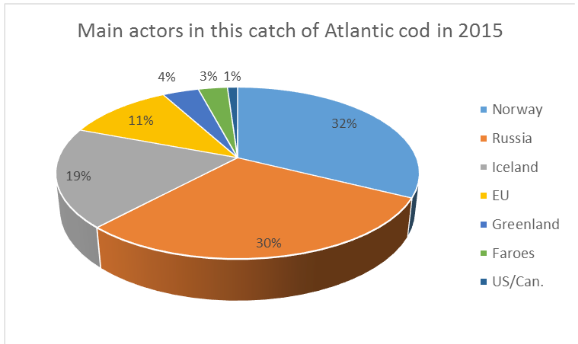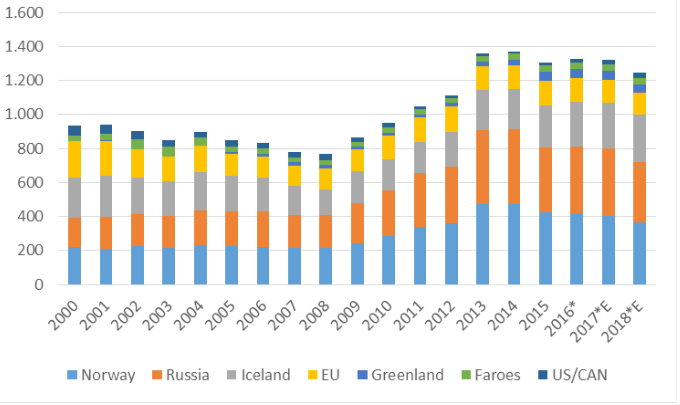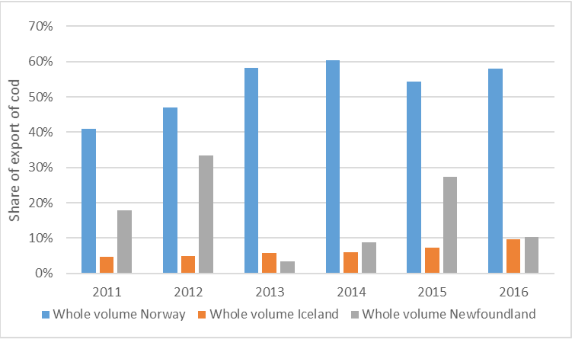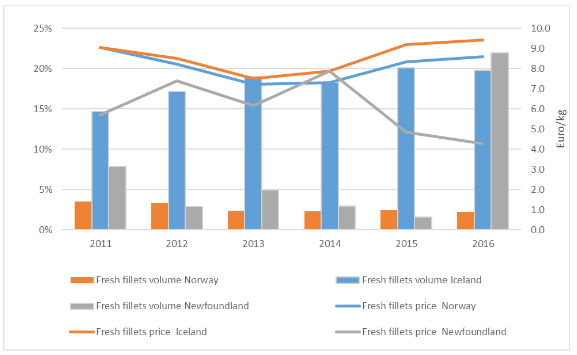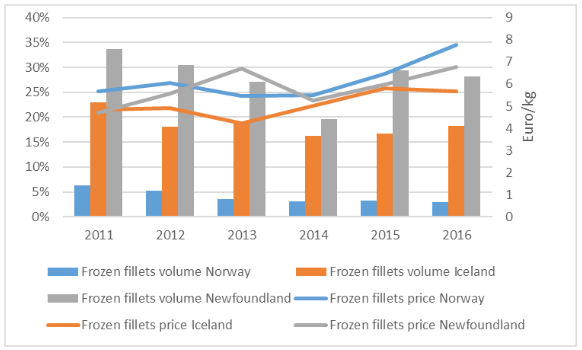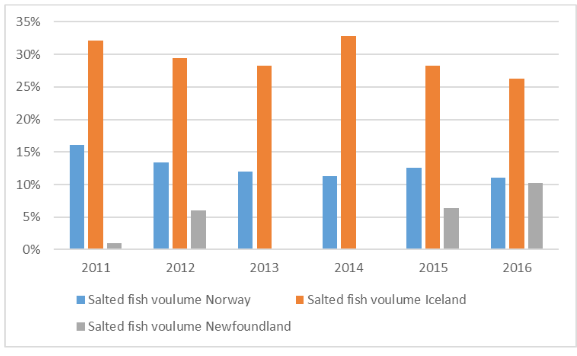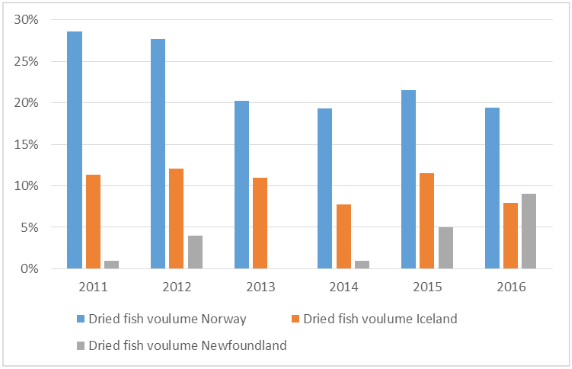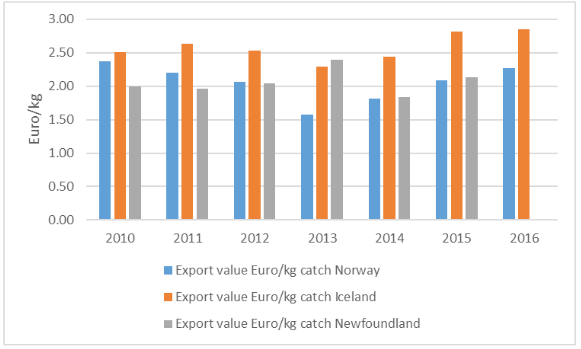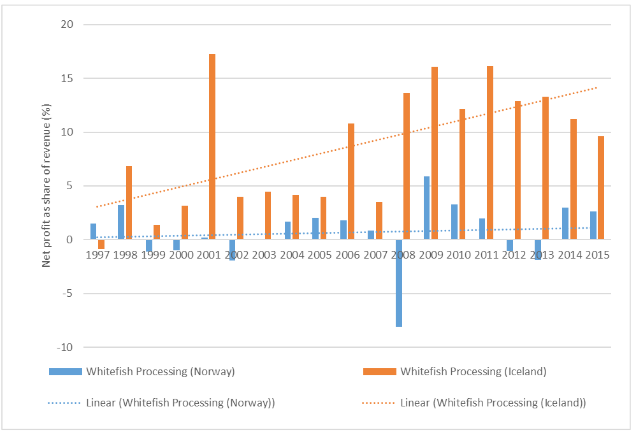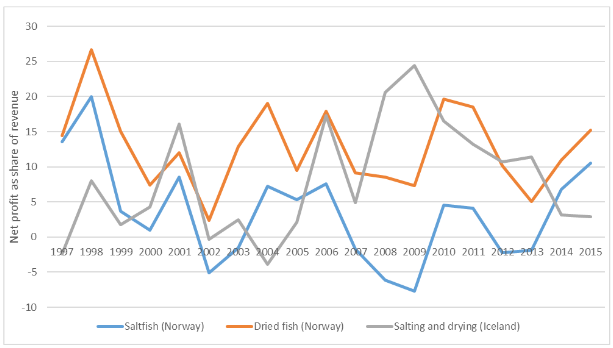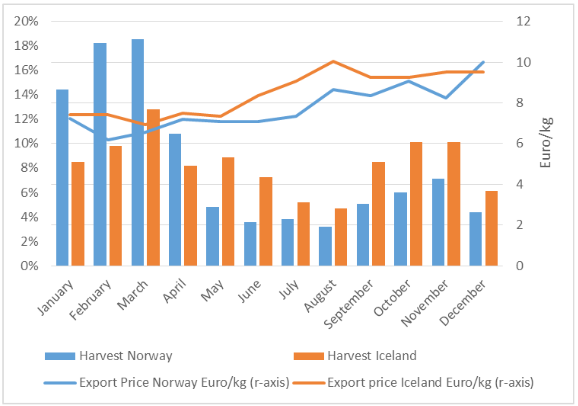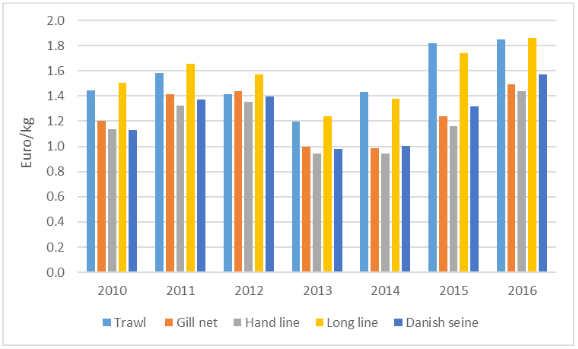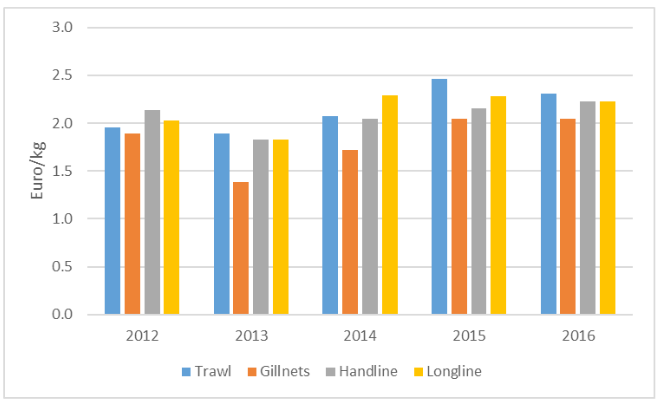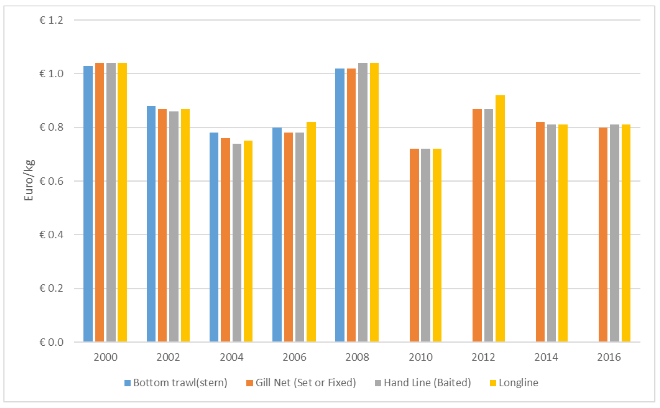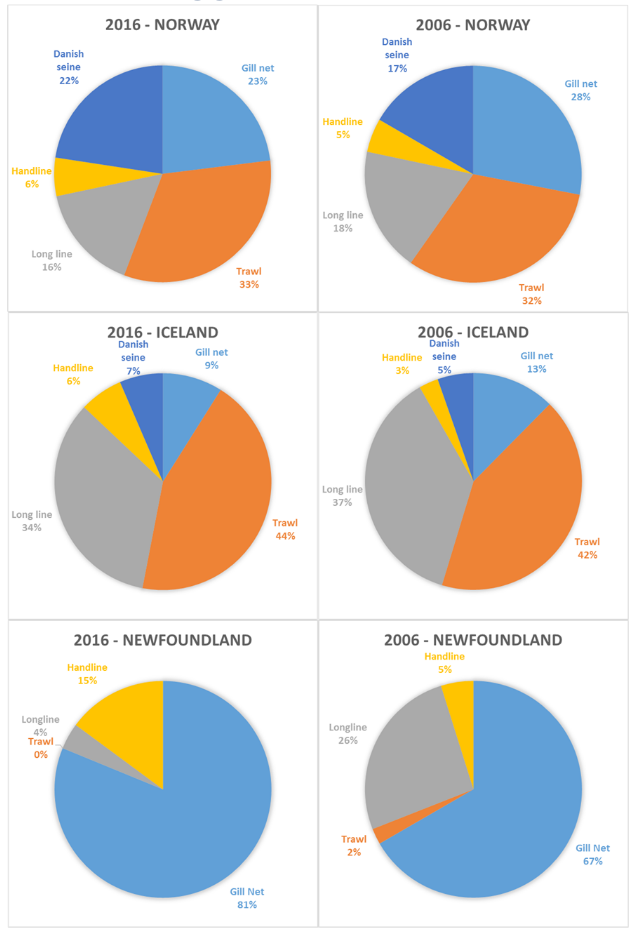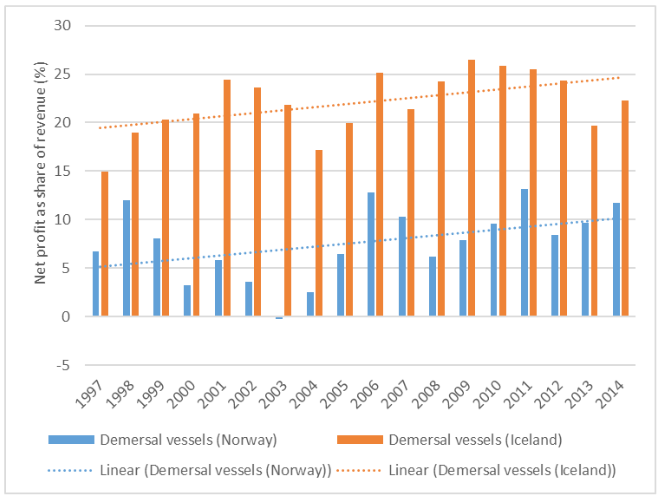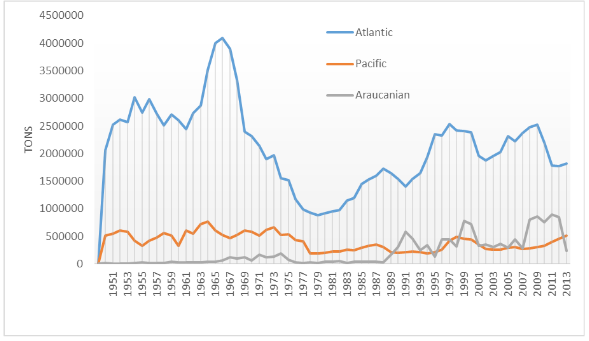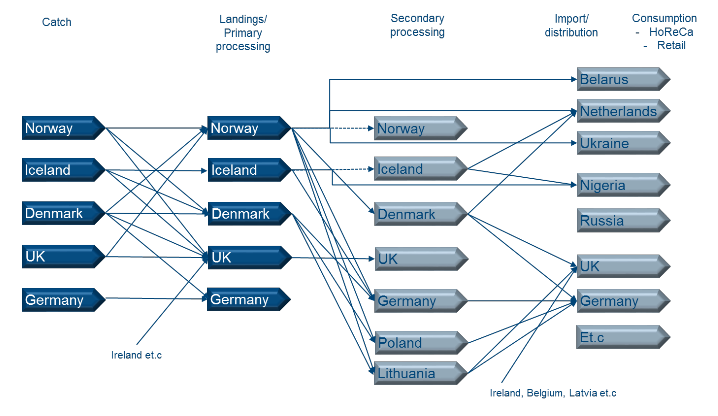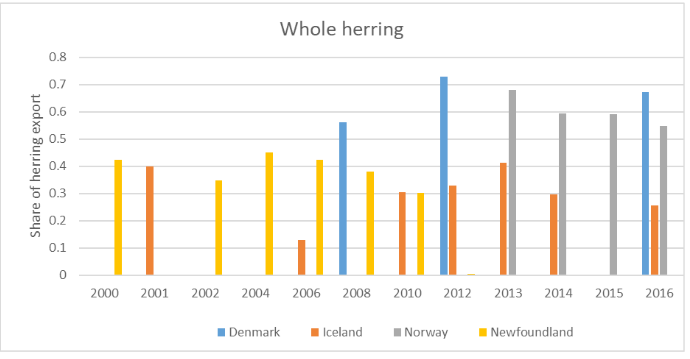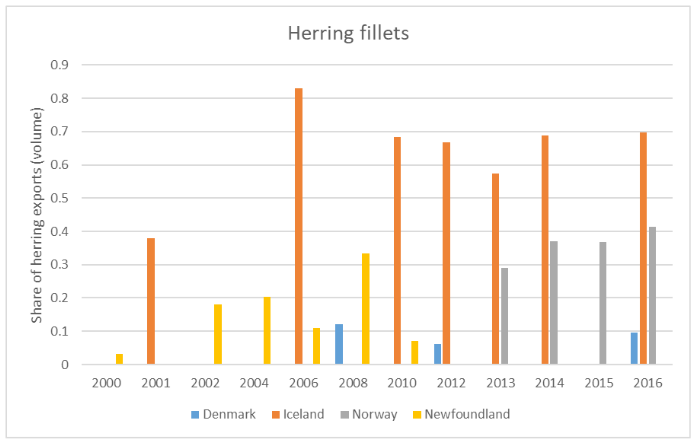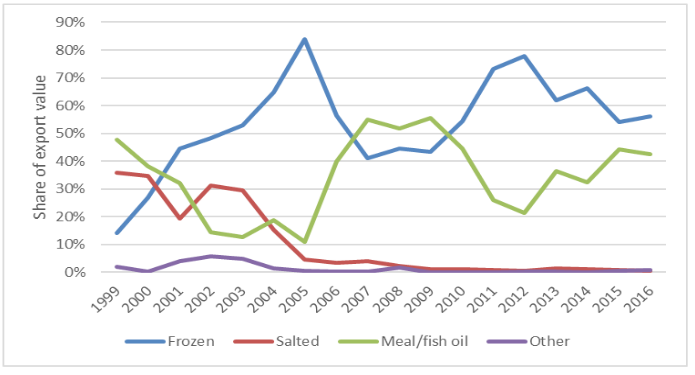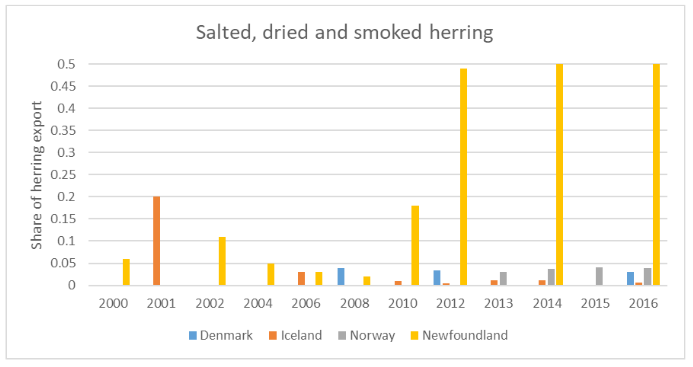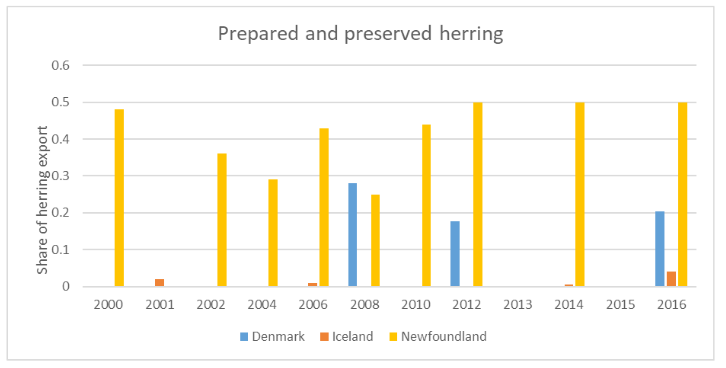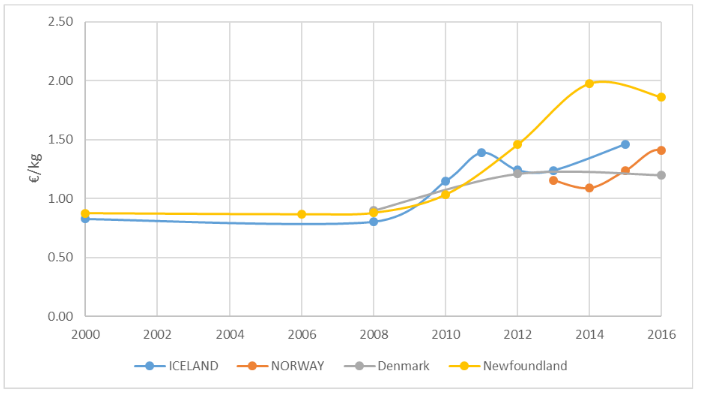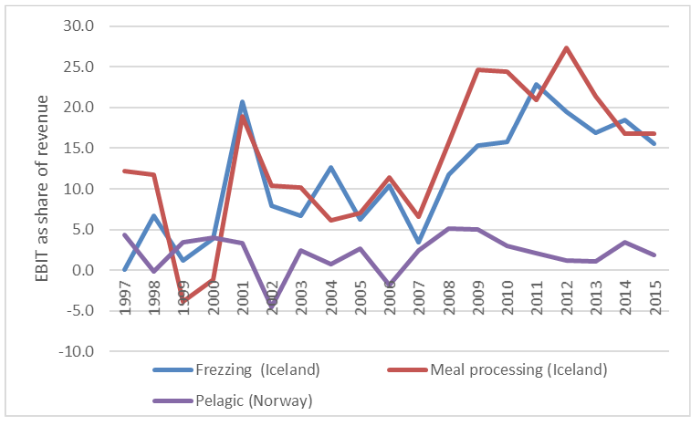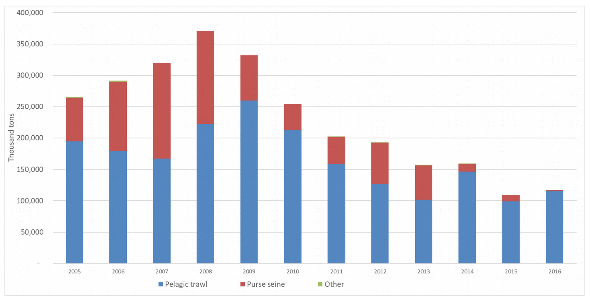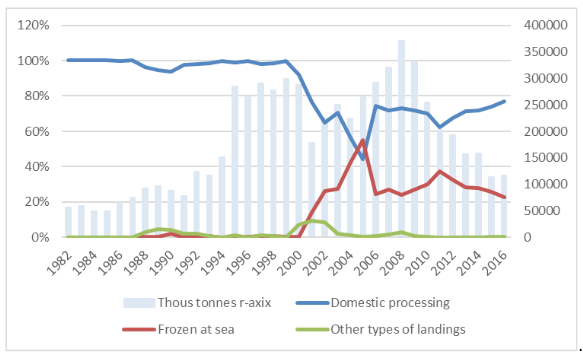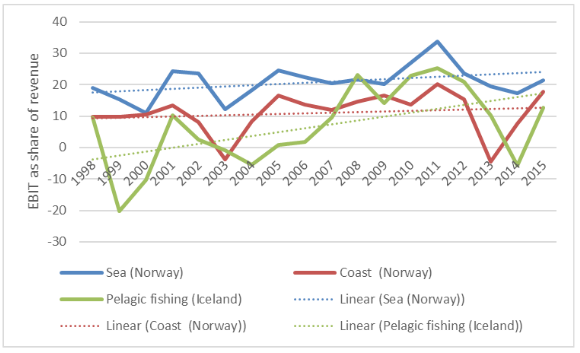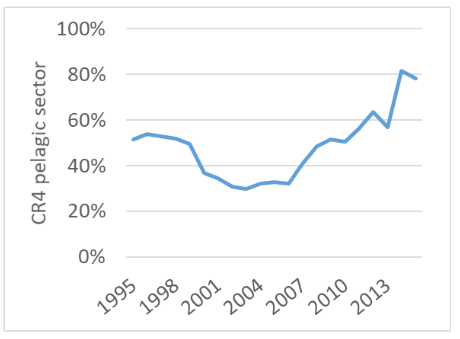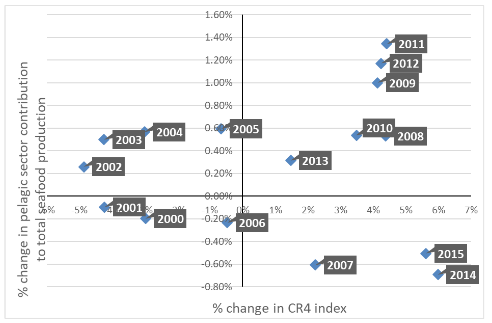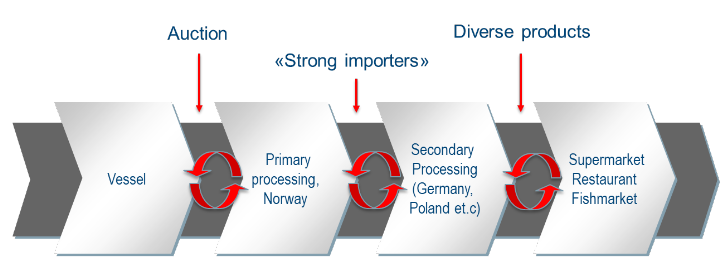Deliverable 3.4
Contents
- 1 Deliverable D3.4 - Report on evaluation of industry dynamics opportunities and threats to industry
- 1.1 Executive Summary
- 1.2 Atlantic cod
- 1.2.1 Summary
- 1.2.2 Global Market review
- 1.2.3 Fisheries Management System in Norway, Iceland and Newfoundland
- 1.2.4 Market approach
- 1.2.5 Processing
- 1.2.6 Price settling mechanism
- 1.2.7 Fishing
- 1.2.8 Consolidation in the sector
- 1.2.9 Overall economic performance and competitiveness of the fisheries value chain
- 1.2.10 Strategic Positioning Briefing
- 1.3 Atlantic Herring
- 1.3.1 Executive summary
- 1.3.2 National comparison
- 1.3.2.1 Introduction
- 1.3.2.2 Fisheries Management System
- 1.3.2.3 Markets- and production development
- 1.3.2.4 Price settling mechanism
- 1.3.2.5 Fishing
- 1.3.2.6 Consolidation
- 1.3.2.7 Overall economic performance and competitiveness of the fisheries value chain
- 1.3.2.8 Strategic Position Briefing
- 1.4 Salmon
- 1.5 Pangasius
- 1.6 Bibliography
Deliverable D3.4 - Report on evaluation of industry dynamics opportunities and threats to industry
Executive Summary
In this report, evaluation of industry dynamics opportunities and threats to industry, we are focusing on value chain dynamic for certain industries and species. The framework used is a bit different for caught species (cod and herring) and farmed species (salmonoids, sea bream & bass and pangasius). The industry dynamics is more value chain focused for the caught species, while individual companies are also the focus for the farmed species. The main results for the caught species reviled very interesting structural difference and functionality of the value chains for cod between Norway, Iceland and Newfoundland. Previous studies have argued that the superior harvesting and marketing strategies of the Icelandic industry may be rooted in factor conditions that are difficult to duplicate and a rigid institutional framework in Norway and partly the social resource structure of the Newfoundland industry, where market conditions have very limited consideration in terms of the structure or management of the industry.
The vertically integrated companies in Iceland where the processor owns its own fishing vessels. Unlike the push supply chain system followed by the Norwegian and partly the Newfoundland companies where they must process the fish that they receive, the Icelandic processors places orders to its fishing vessels based on the customer orders and quota status, thus following a pull supply chain system. The Icelandic processors are able to sends orders to the vessels for how much fish of each main spices is wanted, where to catch and to land so they have the desired size and quality of raw material needed for fulfilling customer orders. This structural difference is also affecting the product mix that the countries are going for.
It is also very interesting to see the difference in structure and functionality of the value chains between Norway, Iceland, Denmark and Newfoundland for herring. The structure of the industries is different as seen in the degree of vertical integration and the limits that government’s put on the industries. It is though surprising how homogeneous the industry is between those nations. The nature of pelagic species that is, seasonality and high catch volumes in short periods, makes the product global commodity for further processing from one season to the next. The main markets are Business to Business (B2B)
The first noticeable difference observed, apart from the structure, is the price settling mechanism. On one hand it is the Norwegian system that builds on minimum price and auction market which is the same that is used to determine the Danish price. In Iceland the price is decided by the Official Bureau of Ex- Vessel Fish Prices. he Norwegian price is in many cases double that of the price in Iceland. The price obviously affects the profitability of the industry as the Norwegian fishing is benefiting from high price but the processing sector is suffering from low profitability. On the other hand, the processing sector in Iceland is doing well as well as the profitability of the fishing is healthy. It can be claimed that the overall profitability is higher in Iceland due to the freedom of strategically positioning yourself in the value chain and being vertical integrated or not, without external limitation as those that can been seen in Norway, Denmark and Newfoundland
Aquaculture is the primary source of salmonid supply globally. The different salmonid species available on the market are substitutable to a considerable extent due to their pink flesh colour and similar properties. However, different dynamics in the broader competitive environment, and in the particular circumstances of national sectors, in which the businesses comprising these industries are embedded, have determined different developmental trajectories for the very same industries. These dynamics include the changing nature of consumer demand characteristics, production technology, national regulatory regimes, international trade, industry structure, availability of natural resources. Discussed in this chapter are the cases of farmed Atlantic salmon and rainbow trout in major producer countries and the role key external influences have played in shaping different developmental outcomes. The interaction of selected salmonid producer firms with their distinct competitive environments is illustrated through firm-level case studies of strategic positioning.
The output of most salmonid aquaculture, and Atlantic salmon in particular, is highly commoditised i.e. there is little differentiation between farms and competition is based purely on price. These products, mostly head-on gutted fresh fish, serve as raw material for further processing. In that situation, large enterprises which can reduce costs of production economies of scale and offer the lowest price, would have competitive advantage.
Seabass and seabream are the most important species for the aquaculture of fish in Spain, being one of the most important markets in Europe. The production and the market is highly concentrated and economies of scale may improve the competitiveness of the sector. The integration of production and the stable international trade allows to increase the share of the price value. The pangasius industry in Viet Nam has grown quickly over the last two decades to become one of the main food exports from the country and a major contributor to the Vietnamese economy. Pangasius products, mainly frozen fillets, are currently exported all over the world, with the largest markets being the EU, the USA, and more recently China. The success in market penetration of pangasius products can be attributed to their mild taste, lack of bones, and most importantly their low price compared to other, more traditional whitefish products, for which it acts as a low-cost substitute.
The production node in the pangasius’s value chain was initially highly fragmented, composed of many small-scale family owned enterprises and middle-scale processor-exporters. However, the industry is undergoing a rapid a rapid consolidation and increasingly being served by large-scale vertically integrated enterprises, encompassing all stages of the value chain. The reasons for that can be found in the improvement in seed production methods, control of fish health and disease problems, feed and nutrition and market requirements.
Atlantic cod
Summary
It is very interesting to see the difference in structure and functionality of the value chains between Norway, Iceland and Newfoundland. Previous studies have argued that the superior harvesting and marketing strategies of the Icelandic industry may be rooted in factor conditions that are difficult to duplicate and a rigid institutional framework in Norway and partly the social resource structure of the Newfoundland industry, where market conditions have very limited consideration in terms of the structure or management of the industry.
The vertically integrated companies in Iceland where the processor owns its own fishing vessels. Unlike the push supply chain system followed by the Norwegian and partly the Newfoundland companies where they must process the fish that they receive, the Icelandic processors places orders to its fishing vessels based on the customer orders and quota status, thus following a pull supply chain system. The Icelandic processors are able to sends orders to the vessels for how much fish of each main spices is wanted, where to catch and to land so they have the desired size and quality of raw material needed for fulfilling customer orders.
This structural difference is also affecting the product mix that the countries are going for. Iceland is therefore placing more and more emphasis on fresh fillets and pieces, while the other countries are going for more traditional products, like salted, dried and frozen products. Due to the vertical integration in Iceland, the production plans are developed based on customer orders and then a plan is made for fishing, while in Norway and Newfoundland, the production plans is usually developed after receiving the fish at the processing plant as the information about volumes of specifies caught and quality is not available beforehand.
Global Market review
According to a book by Mark Kurlansky; ”Cod - A Biography of the Fish that Changed the World”. Cod was the reason Europeans set sail across the Atlantic, and it is the only reason they could. What did the Vikings eat in icy Greenland and on the five expeditions to America recorded in the Icelandic sagas? Cod, dried in the frosty air. What was the staple of the medieval diet? Cod again, sold salted by the Basques. As it turns out, cod has sparked wars, shaped international political discourse, impacted diverse cultures, markets, and the environment.
Cod importance has dwindled, but it is still of major importance to Iceland and Norway and growing importance in Newfoundland and therefore it is important to look at industry and market dynamics, opportunities and threats in the value chain of cod for these countries.
Main producers
Atlantic cod is only one of many species entering the global supply chain for whitefish, which can be viewed as substitutes. Amongst them, we find Alaska pollock, hake, saithe, Pacific cod, haddock, hoki and Atlantic redfish. Altogether, the global supply of these species in 2015 was about 6,937 million tonnes, according to FAO. The largest species by far is Alaska Pollock, for which the catch in 2015 added up to 3.3 billion tonnes – 48 per cent of the total whitefish supply – for which US and Russia are the largest actors.
Atlantic cod was the second largest species in the global whitefish supply in 2015, responsible for 1,304 million tonnes, or 19 per cent of the total. The main actors in this catch of Atlantic cod in 2015 was Norway, Russia, Iceland and the EU with 11% of the catches as can been seen in figure 1. The main actors among the EU countries are Denmark, UK, Germany and Poland. The main suppliers since the turn of the century are shown in Figure 2.
Figure 1. Main actors catching Atlantic cod in 2015 according to FAO
Figure 2. Supply of Atlantic cod from the North Atlantic waters, by country, 1000 tonnes, 2000–2018. Source: FAO and (*) Groundfish Forum
FIgure 2 shows a relatively stable distribution of cod catches until the increase in the quotas for Northeast Atlantic cod about 2009, where Norway and Russia increased their share. Moreover, it shows that the catch of US/CAN fell until the end of this period, when it rose again, and that Greenland catches have increased over the period. As can been seen in Figure 2, The International Council for the Exploration of the Sea (ICES) has recommended a 20 percent cut in the Barents Sea cod quota for 2018. However, the Joint Russian Federation- Norwegian Fisheries Commission in October 2017 agreed on the 2018 quotas, which include a 13 percent cut in the Barents Sea cod quota to 775.000 tonnes (FAO).
Main markets
The EU is by far the largest market for cod products in the world. Cod is processed in different format to fulfil the needs and customs of different markets. There is a big consumption of fresh and frozen product in EU, especially in UK and France. The tradition of drying fish to preserve it dates back to Viking times, but the process of salting fish began in the 15th century, when the Iberian fishermen were sailing to and from Newfoundland. Cod that had been preserved in salt would last the length of the journey. Clipfish/saltfish or bacalao is also popular in Catholic countries, thanks to a tradition that dates back to the middle ages when the pope ordered Catholics to eat fish instead of meat during Lent. Therefore have Iceland and Norway exported bacalao for centuries to Catholics around the world, especially to Spain and Portugal. There are also number of other traditional markets, like Nigeria for dried fish parts and heads. USA was also a big market for cod products, and it has been growing again in recent years, especially for fresh cod.
Cod producers from Norway have been taking putting effort in emerging market like China, where there is great potential but no custom of consuming cod products.
Figure 3. Trade of cod in the EU, Import of cod products in the EU, both extra and intra EU trade. Raw data from EUMOFA.
The total import in the EU was 761 thousand tons in 2016 and the imports in total have been on the rise in recent years. That don’t mean that this came all from outside of EU. Part of the imports (42.1%) came from Intra EU trade while the larger part (57.9%) came into the EU from countries outside the EU, like Norway and Iceland. Largest part of the EU export figures of 421 thousand tons are Intra EU trade or 94.1%, therefore there are only around 25 thousand tons of cod exported out of the EU to non EU countries.
Frozen cod is by far the most common preservation form of traded cod in the EU as can been seen in Error: Reference source not found. The import of dried, salted and smoked cod products have been relatively stable in recent years but the main growth has been in the import of frozen and fresh cod products. The imports of fresh cod has been on the rice since 2008, but 2015 the volume went down but gained momentum again in 2016. The imports of prepared or preserved products is low but relatively stable between years.
Fisheries Management System in Norway, Iceland and Newfoundland
General
Norway
“The main objective for the industrial and fisheries policy is the highest possible value creation in Norwegian economy, within sustainable limits. The Ministry of Trade, Industry and Fisheries work is to obtain this main objective builds on the following sub- objectives: efficient use of society’s resources, increased innovation and adaptation ability, and companies who succeed in international market. The sub-objectives and prioritised areas to achieve these are just as important for the seafood industry as other activities in Norway. A purposeful superior effort to stimulate to increased innovation and adaptation ability in Norwegian economy is of great importance also for the seafood industry.”
Iceland
Iceland seafood sector is modern and competitive, based on sustainable harvest and protection of the marine ecosystem. Marine products have historically been the country’s leading export items and the seafood industry remains the backbone of the economy. The fisheries management in Iceland is primarily based on extensive research on the fish stocks and the marine ecosystem and biodiversity, and decisions on allowable catches are made on the basis of scientific advice from the Icelandic Marine Research Institute and catches are monitored and enforced by the Directorate of Fisheries.
Newfoundland
Fisheries and Oceans (DFO) is responsible for management of the Canadian fisheries stocks in accordance with the roles and responsibilities outlined in Canada’s Fisheries Act. The major objectives and priorities of the DFO’s fisheries management policies include ensuring environmental sustainability and conversation of the resource, ensuring access based on adjacency or proximity to the resources, consideration of the relative dependence of coastal communities and the dependence of various fleet sectors, as well as factors such as economic efficiency and fleet mobility. Inclusion of stakeholders in the decision-making process is regarded as a key priority for fisheries management in Canada (Fisheries Management Decisions, 2017; Sustainable Fisheries Framework, 2017).
Quota system: Individually Transferable Access
Norway
- Rule of thumb: Off-shore vessels governed by licenses, and coastal vessels by annual
participation rights (off-shore conventional vessels excepted).
- In order to get a fishing quota you have to buy a vessel (a pre- requisite is loosened up in later
years, where one nowadays can get hold of structured quotas, without factual vessel transactions). Transferability has increased, buts still with great imperfections compared with an ITQ-regime.
- Quota distribution to vessel groups (coastal vs. off-shore, and different size classes within
the coastal vessel group) based on allocation formulas agreed within the Norwegian Fishermen Association, upon historical rights. Still with some autonomy for the authorities to allocate certain shares of quotas to special schemes (youth, recruitment, R&D, etc.) before allocation to vessels.
- Regional distribution safeguarded by fleet composition, and limited transferability between regions
for some licenses/participation rights.
- Quota year is the same as the almanac year.
Iceland
The ownership of quotas involves the right to catch the fish but does not entail ownership of the fish stock. Thus, it is claimed that the quota does not mean the ownership of the fish but rather the right to catch the fish. Since 2001 small boats has been allocated TAC (Total allowable catches) and all effort based system abolished until 2009 when coastal fisheries was introduced. As can be seen in figure the share of small boats of the TAC was 14.2% in 1992 and is 22.3% in 2016. It peaked in 2001 when it was 24.1% of the TAC in cod. Part of this increase can be explained with changes in classification of small boats as in 2013 when small boat definition went from 15 gross registered tonnes (GRT) to 30 GRT.
- The emphasis of the fisheries management system since 2001 has been to simplify the system and bring all into the quota
system of ITQ and TAC system. Against this, open access fishing was introduced in 2009 when new system was introduced for small boat called costal fishing (isl. strandveiði).
- By the 1990 Act the fishing year was set from 1. September to 31. August in the following year but previously
it had been based on the calendar year. This was an effort to channel fishing of the groundfish stocks away from the summer months, when quality suffers more quickly and many regular factory workers are on vacation.
Newfoundland
Generally, DFO allocates quotas for each stock/species (or group of species) in accordance with a specific fishing season and within a specified fisheries management division. The key regions or fisheries management divisions for cod quota or allocation in NL are:
- 3K (including 2J3KL)
- 3Ps
- 4R (including 4R3Pn)
Information included in a fisheries decision may include:
- opening and closing dates for the season,
- total allowable catches (TAC),
- and management plans (Fisheries Management Plans, 2017) with certain fisheries managed through multi-year Integrated Fisheries
Management Plans (Integrated Fisheries Management Plans, 2017). In Newfoundland, Atlantic cod are managed through a series of strategies. Pending the NAFO region, the cod fishery can be a set quota, a weekly allowance or allocation, or may be an experimental fishery. Based on principles of adjacency and the numbers of vessels /harvesters participating in the fishery, the coastal fleet (<65 feet) has a strong position within the NL fisheries sector.
Entry barriers into the system:
Norway
The activity demand in the Participation Act states that in order to own a fishing vessel one have to be an active fisher.
- Many exceptions have been granted. Firstly, on the same footing as active fishers are administrative fishing vessel
owners – caretaking the daily operation of vessels from land. Also, as the filleting industry in the north of Norway was built up and prioritised as whole year employers, many filleting firms were granted cod trawl licenses, which today are held by two big processing concerns (Lerøy and Nergård)
- To become a registered fisher, you have to live in Norway and work on a registered Norwegian fishing vessel
- To get a vessel registered a as a fishing vessels, demands have to be met regarding size class and operating areas.
Like in other western society fisheries, the closure of the commons have increased the capital intensity, and labour is to a large degree substituted by capital intensive production equipment. Foreigners can buy vessels below 15 meters in Norway and control no more than 40 per cent for boats above 15 metres. Processing industry - no nationality limitations exists
Iceland
All professional fishing in Iceland has to have licences for fishing.
- Capital intensive due to high price of quota
- Entry for foreign investments very limited (or closed).
- Economics of size Costal fisheries
- In 2016 total 9790 thousand tones are allocated for coastal fishing one open access base from May to August.
- Open access
- Low profitability (returning loss for all years of operation)
- Coastal fishing is limited to small boats with maximum two handlines per person and
maximum two person on the boat. The maximum 650 kg catch per day and fishing is limited to four days a week.
- There are also limits of TAC for each area for the small
boats.
Newfoundland
No new licences being issued by DFO
- Entry into fishery is based on acquisition of existing licences
- Requires a professional fish harvester certification
- Significant investment in terms of education and training and at-sea experience
- Cost of entry into the fishery is prohibitive due to the high cost of capital investment (vessels,
gear, etc.) and the cost of licences
- Uncertainty over future allocation/quotas and if there will be return on investment
Exit barriers from the industry
Norway
- Exit barriers are fewer Vessel owners are unable to recover the full vessel value as they exit the industry.
- However, the increase in quota prices over the years should cover for such discrepancies.
- Limited transferability between regions in some vessel groups.
Iceland
- Low exit barriers quota easily sold and market open
- No tax limitation for selling the fishing rights and ITQ.
- Unlimited transferability between regions
Newfoundland
- Low exit barriers licenses are easily sold; open market for licence
- No regulations governing the sales
- Exit not linked to potential resource re-allocation for new entrants; i.e. portion of
share or allocation is not reinvested back into the fishery
- No financial reinvestment (e.g.no tax or fee) required to be paid by harvester upon
sale of licence and exit from the system
Quota ownership and quota prices
Norway
There is in Norway a consolidation limit for cod for both conventional off-shore vessels (auto-liners) and cod trawlers, but not for coastal vessels.
- Firms owning conventional off-shore vessels cannot, directly or indirectly, own vessels that
control more than 15 per cent of the group quota for any of the species included.
- For cod trawler, firms cannot control more vessels exceeding more than the number that
controls 12 quota factors. With today’s quota ceiling (maximum four quota factors per vessel), it means 3 full structured vessels and about 13 per cent of the group quota for cod trawlers.
- However, there are specific rules for ship owners that also own
processing facilities, which is the reason that the two before mentioned cod trawler ship owners have more vessels than the limit of the Act. Quotas can be transferred among vessels in a vessel owning company, but only upon authorities’ approval. Also, other eases of transferability exist (renting quotas, ship wrecking, replacement permit – in awaiting of new vessel, and others) A quota flexibility between years is also possible, but within the cod fishery, this is only possible on group level – not for individual vessels. An overfishing of the vessel groups’ cod quota one year will be claimed against next year’s quota, and vice versa if the full quota is not taken. For the vessel groups with a limited number of vessels, this individual vessel quota flexibility between years will be effectuated over the turn of the year from 2017 to 2018. Coastal vessels will have to wait longer until this can be effectuated, since so many extraordinary schemes exists for these vessels Quotas within Norwegian fisheries are transferable, but there exists no central brokerage system where quota prices are noted.
Iceland
Limitation on consolidation of quota ownership – max 12% ownership of TAC for each species.
- Quota is bound to fishing vessel but companies with number of vessels can transfer quota between vessels.
- 15% of TAC can be transferred between years by companies
- 5% can be overfished in the fishing year and will then be withdraw from the companies next year TAC
TAC cannot be transferred between systems, example from the hook system to the general TAC system
- There is regional restriction to fishing in the coastal fisheries
- The fishing ground is split into 4 areas
Newfoundland
Transferability allocation of quota/weekly
- Limit on combining (maximum set at 2:1 or 3:1) shares or allocation for inshore fleet
- Transfer of shares/allocation between vessels is permanent (inshore fleet);
- Larger offshore vessels can transfer quota between vessels annually- it is not permanent
- Opportunity to buddy-up is limited or restricted based on region and season
Possibilities to upgrade in the system
Norway
Upgrading is possible, but is capital intensive. Opposite to the fishing industry, no license is needed to erect processing capacity. Upstream vertical integration (towards the fishing fleet) is prohibited, while downstream (from fleet to processing) allowed. Less cod in onboard processed in the off-shore over time, but more is sold as frozen HG.
Iceland
Limitation to move between systems
- hook system is looked in there but can be transferred inside that system
- Small boats can enter the costal fisheries even if they are operating in other systems.
- only requirement’s is during that time they only operate in costal fisheries.
Newfoundland
- Limited opportunity for vertical integration based on PIICAF and allocation of first 115,000
tonnes to inshore sector
- Upgrading is based on number of licences purchased
Management measurements
Norway
Landing obligations are not a subject in Norwegian fisheries, since it is mandatory to land all caught fish. Delivery obligations have nevertheless been put on about half the cod trawlers in order to see to it that fish is landed where it was supposed to, in the cases where processing firms were granted cod trawler licenses but where ownership to trawlers have been dissolve during the years. No limits exists to how much a vessel can land on a daily basis.
- safety limits to how much cargo a vessel can hold, and
- also a general rule that “a vessel should not carry more than it can take care of in a reasonable manner”,
- but no limits exist as to what is the limit for daily catches in order to enable a best possible raw material quality.
Iceland
Landing obligation
- None, except in coastal fisheries the fish has to be landed before 16:00 and in harbours in the fishing zone
- Delivery obligations are not in place in Iceland and no processing requirements
Fishing days – regulations/number of days
- Coastal fisheries have limitation (4 days pr. week/4 months)
- Gear restriction in the hook system
Quantity
- In the coastal fisheries system
- Max 650 kg pr. day/14 hours pr day
- TAC for each area
Closures
- Marine Institute has licences to introduce closures fishing areas if for example share of small fish
is too high according to landing or historical landing data Discard ban
- There are measurement’s in place to avoid discard
- Limited withdraw on unwanted catch form TAC
- Up to 5% of fish that is damage can be landed as VS fish special weighted and not withdraw from TAC
Newfoundland
Landing obligation
- must land all catch unless a species exemption is received from DFO
Minimum processing requirement
- cannot process at sea
Fishing season
- determined annually; reportedly based on ease of access to the fishery and not linked to market conditions
Gear restriction
- in place (e.g. fixed versus mobile gear)
Market approach
Differences in exports
It is interesting to look at the nature of the export from each of the value chains; that is whole fish, fillets, salted products and dried fish.
Figure 4. Export of whole unprocessed fish from Norway and Iceland as share of total exports.
- Export of whole fish from Norway has rather been increasing in the recent
years. Part of that could be the increase in catch in Norway or from around 215.000 thousand tons in 2008 to 422 thousand tons in 2015. This export is both frozen H/G (headed and gutted) and fresh.
- Norwegian have focused a lot the last year of marketing their H/G fresh
fish as Skrei where they select the best fish for export under the brand name Skrei and receive premium for that export.
- Export from Iceland has been increasing slightly and is mainly fresh with
head on and is up to 9.7% in 2016 from 4.1% in 2011.
- Newfoundland export of whole fish fluctuates a lot between years;
somewhat determined by the fluctuating TAC and weekly allocation/permissible catch rates. Another way to look at the processing stage of the value chain is to look at the share of fillets in the export from those countries. In figure 3, all filletsexport is summarized. This takes into account whole fillets, fillets portions and fillets from different processing; fresh, frozen and dried.
Figure 5. Total share of volume of fillets in export from Norway, Iceland and Newfoundland.
- Fillets production is very limited in Norway and accounts for less than 10%
of the export in 2016 and the share has been decreasing. The fillets production is mainly frozen in Norway.
- Iceland Fillet production is stable from around 55% to almost 60% of the
total export. The 12.1 % of the export are fresh fillets or fillet parts, 21% is frozen and 10.3% are salted both frozen lightly salted and as salted fillets.
- Newfoundland export of fillets fluctuates between years.
The most valuable fillets production is the fresh fillets or fillet portions. In Figure 6 the fresh fish fillet export is expressed with export value per kg of fillets exported
Figure 6. Share of export for fresh fillets by volume and average export price.
- The volume of fresh fillets as a share of the total export in Norway has
been decreasing in share although the real quantity has not been reduced as the share as quantity of landed cod has increased considerable in this period. It is interesting that the price per kg of exported fillets are lower than for Icelandic fillets, which could suggest more export of whole fillets instead of fillet portions (loin cut) export from Iceland or lower price in the market.
- The export of fresh fillets has been increasing it share in Iceland as well as
price per kg which can mainly be traced to higher degree of portioning in Iceland today due to water jet cutting in the processing part of the value chain.
- The share of fresh fillets in Newfoundland was decreasing from 2011 when
it was 10.1% to 2015 when it was 1.5%. Then in 2016 it was up to 22% of the total export. Price of the export is in most cases (except 2014) much lower than fresh fillets from Norway and Iceland.
Figure 7. Share of export for frozen fillets by volume and average export price.
- The share of the Norwegian frozen fillets export is decreasing or from
around 6% in 2011 to 2.9% in 2016. What is interesting is that the Norwegian receive higher price per kg of fillet than Iceland. One reason for this could the focus of fresh fillet portions (loin cut) in Iceland leaving the tail and belly flap behind less valuable part of the fillet.
- Newfoundland have just under 30% of their export in frozen fillet and the
price is in between Iceland and Norway except for 2013 when they receive the highest price of the three nations. The traditional markets of cod from all the three countries is the salted fish markets mainly in the Mediterranean countries.
Figure 8. Total share of volume of salted fish in export from Norway, Iceland and Newfoundland
- Salt fish export form Iceland is divided between fillets and split fish. The
share of export of split fish has been decreasing and the share of fillets increasing.
- The Norwegian export is mainly spited fish or clipfish dried salted that is
counted as dried fish.
- The NL export consists of cod fillets dried and salted in brine (with/out
smoking) and wet salted
The export of dried fish is also important for Norway and Iceland but not for the Newfoundland cod. The total share of salted and/or dried fish for NL has decreased over time. Between the years 2005-2010, NL salt fish exports ranged from 8-37% of total exports. This decreased from 2011-2016 where exports varied from 0% to 8.5%
Figure 9. Total share of volume of dried fish in export from Norway and Iceland
- The export of dried fish from Iceland is mostly dried head and frames.
- The Norwegian export is stock fish. The main markets is Italy, which
Norwegian have overtaken almost completely.
To summarise the marketing and production part together, it is interesting to look at how much value each of the value chains are returning for per kilo of cod. From Figure 10 it can been seen that from 2010, Iceland has in most cases been returning highest value per kg of cod.
Figure 10 Total value of export per kg of cod landed
- This method of calculating value creation does not take into account stock
in the beginning of the year or at the end of the year. So that could affect the numbers especially in Newfoundland that focuses on frozen products.
Summary of main influencing factors regarding market approach
| Factor | Iceland | Norway | Newfoundland |
|---|---|---|---|
| Degree of processing | Focus on:
|
Raw material exporters.
Focus on:
|
Focus on:
|
| Marketing | Limited mainly based on individual companies | Medium, based on central focus of Norges rafisklag and individual companies.
Producers and fisherman pays fee for marketing of Norwegian seafood |
Limited or based on individual companies |
| Risk in marketing | Rather high. Depend on rather few countries. 94% of the export goes to 10 counties | Medium. Emphasis on marketing and selling to many countries. 86% of exports go the 10 countries | High, Depend on few countries |
Processing
Profitability and performance
Looking at the profitability of the processing sector as a whole as net profit as a share of revenue it is clear that the Norwegian industry is behind the Icelandic processing sector regarding these criteria. The trend line for profit for the processing sector is but much steeper in for the Icelandic sector than for the Norwegian one. The Norwegian processing sector has been suffering from low profitability in recent years. Information about profitability is not available from Newfoundland.
Figure 11. Net profit as share of revenue (Profitability) for the processing sectors in Norway and Iceland 1997-2015.
It is interesting to look at the difference in performance for the salting and drying sectors between Iceland and Norway.
Figure 12 Net profit as share of revenue in salting and drying processing sectors in Norway and Iceland 1997-2015
Main issues:
- The best profit in Norway is in dried stockfish and clipfish, that is dried
salted fish. Salting and drying in Iceland is mainly salt fish. Light salted and even light salted and frozen. Profitability is much higher than in salted production in Norway, where production is mainly traditionally salted fish.
- Stockfish production in Norway is returning healthy EBIT for most year. The
stockfish production is aimed for high end niche markets in Italy and lower value markets in Nigeria.
- Drying of whole fish is very limited, the main product of the drying sector
in Iceland are heads and bone frames.
Figure 13. Net profit as share of revenue in filleting processing in Norway and frozen production in Iceland 1997-2015
- Compering export and profitability on fillets production it is possible to
compare the frozen production in Iceland with the filleting production in Norway. The frozen products from Iceland are mainly fillets or fillets portions. It is obvious that there is great difference in profitability although the profitability in Norway has been improving since 2008. One of the influencing factor on the performance of the processing industry is the flow of fish to the processing part. It is interesting to see the distribution of catches for Norway and Iceland as is done in Figure 14, were the flow is shown as monthly share of total catches for the year vs. export price of fresh fillets for these countries in 2014.
Figure 14. Monthly catches of cod as share of total catches for 2014 and export price in Euro per kg for fresh fillets.
- Norway has around 62.1% of the total catch landed in the first four months
of the year while in Iceland the 39.2% of the total catch is caught during that period.
- During the first four months the price is lower than in the rest of the year
and Iceland receives higher prices every month, except in December.
By-products
Product export statistic from the countries are not comparable making it difficult to estimate the utilisation of the cod. However, the availability and the critical mass needed for creative usage of by-products is always facilitated by the size of processing facilities and level of automation.5.3 Summary of main influencing factors regarding processing
Summary of main influencing factors regarding processing
| Factor | Iceland | Norway | Newfoundland |
|---|---|---|---|
| Profitability | High | Low | Undetermined |
| Degree of processing | Medium/fillets | Low | Medium/fillets/frozen |
| Flow of raw material | Stable controlled by the processing marketing needs | Seasonal controlled by the catch and seasons | Seasonal controlled by catch limits (weekly limits may vary within
the same season) and fisherman’s willingness to sell to processing companies |
| Structure of the industry | Vertical integrations | Ban or limits to vertical integrations | Limited vertical integration; Regulations in place to limit
increase in vertical integration |
| Vertical integrations | High | Low | Low |
| Flow of raw material | Stable controlled by the processing marketing needs | Seasonal controlled by the catch and seasons | Undetermined |
Price settling mechanism
One of the factors determine the dynamic in the value chain is the first gate price that the industry is capable of paying for the raw material and the form of selling. It is also interesting to study how effective the price settling mechanism is in rewarding for attributes of the raw material, like quality and fishing gear used. In Figure 15 development of the first gate price is expressed as weighted average price.
Figure 15. First sale price as weighted average price for cod in Norway and Iceland 2000-2016.
Iceland has three ways of exchanging fish:
- Auction markets sells around 16% of the total landed cod,
- The VICs are responsible for around 70% of the landed catch and process
most of the catches in own processing facilities. The price to the VIC ́s is connected to the auction price in Iceland.
- Contracts between individual boat owners and producers is responsible
for 14% of the first sales. In Norway there are two main form of trade of fish from fisherman to producers:
- Fresh fish is traded upon direct agreements between seller and buyer, but
with minimise price settling according to Act of the Fish Sales organizations (Fiskesalgslagsloven), which gives sales organizations owned by the fishers monopoly in the first hand trade of fish. In the case of cod, two of those organization are responsible for nearly 99 % of all cod landed by Norwegian fishers (in 2016). The sales organizations are responsible for setting minimum prices for fish which is in most cases the price in the transaction.
- Frozen fish is sold on auction or by own acquisition, where the vessel
owner upon landing himself takes care the sale of fish. In general, frozen cod either goes to clipfish production or is exported unprocessed abroad, while fresh cod to a greater degree is processed where it is landed. In Newfoundland first hand price is negated before the start of the respective fishing season.
- This is done by The Fish, Food and Allied Workers Union (FFAW) and the
processing companies convene as a price settling panel to negotiate the first gate prices paid to harvesters.
- The grade or quality of the product constitutes the price received with cod
graded as either Grade A, B, C, or reject. The negotiated price is considered the minimum price and it is often augmented by the processing companies.
Price according to fishing gear
It is important to understand if the price settling mechanism is rewarding fisherman for attribute that could affect the value creation in later stages in the value chain. These attributes are for example quality, timing, size of fish, fishing gear and temperature of the fish. It is impossible to evaluate all those factors, but it is possible to evaluate the ability of the price settling mechanism to pay different price according to fishing gear.
Figure 16. Norway, price according to fishing gear Euros/kg 2010 to 2016
It is clear that the price is different in Norway after according to the fishing gear.
- Longline and trawl receive the highest price but it is interesting that hand
line usually gets the lowest price which is in contrast with the general believe that hook and line fish have the best quality. The price difference is quite high or up to 0.58 euro in 2015 between the highest and the lowest. Which means that the lowest price in 33% lower than the highest.
Figure 17. Iceland, price according to fishing gear Euros/kg 2012 to 2016
Price varies according to fishing gear in Iceland.
- The same trends can be detected as in Norway that the longline and trawl
receive usually the highest price. Gillnets receive the lowest price but hand line receive the highest price in 2012, although the share of the total landed cod is rather low.
- The price difference between the highest and lowest price range between
0.25 to 0.51 euros per kilo and is biggest in 2013 when the difference is 27%.
- It is interesting to see the difference in price between hand line in Norway
and Iceland that races questions about quality and the how active the price settling mechanism is in identifying and rewarding for quality.
Figure 18 Newfoundland, price according to fishing gear Euros/kg 2000 to 2016
In Newfoundland there is no difference according to fishing gear indicating there is no efficiency in the price settling mechanism to identify quality and pay incentives for that. There are recent examples were processing companies are engaged in collaborative relationships with harvesters and are paying higher premiums to those using fishing gear that produce a premium product.
Summary of main influencing factors on value chain dynamic
| Factor | Iceland | Norway | Newfoundland |
|---|---|---|---|
| Price settling | Auction markets Price settling committee but the auction price is
used as benchmark for other prices calculations in vertically integrated companies (VIC). |
Minimize price decided by sales organizations owned by the fishers for fresh
fish Frozen fish is put up to auction |
Minimize price negotiated in the beginning of the season |
| Market activities | Active | Limited | Low |
| Transparency in price settling | High Transparency in price formation – online auctions.
Equal access to auctions. Price to harvester has increased. |
Low | Low |
| Dynamic of the price settling mechanism | They play important role in returning marketing signal to the harvesting sector
making price formation transparent and market based Provided necessary quality incentives Facilitate the utilization of by-products |
The price settling mechanism has been effective in avoiding “noise” or sharp changes
on fish price to fishermen. Less part goes through auction markets of the offshore fish. |
None or limited |
| Different price according to fishing gear | Active | Active | Limited |
| Quality | Not possible to evaluate | Not possible to evaluate | Not possible to evaluate |
| Role of Auction markets regarding Specialisation | The auction markets have support specialisation in processing. Transforming heterogenetic raw
material into standardise lots for processing (spices, size,quality) |
Limited | Limited |
| Role of Auction markets regarding flow of raw material | They provide a stable flow of raw material to many small processors, creating a lower entry barrier for
entrepreneurs in fish processing. Helps maintaining competition in the processing. Foreign companies are on the market. Even out short run catch variations. Pressed for new product mix. Create channel for by-catch species and undersized fish. Creates critical mass in small species/economic of scale Supported more efficient logistic |
Seasonal flow of material | Auction markets non-existent. Seasonal flow of material |
Fishing
Fishing gear
Figure 19. Newfoundland, Icelandic and Norwegian cod catch by fishing gear as share of total catch for the years 2016 and 2006.
Use of gillnets in Newfoundland had been dominated fishing gear accounting for around 80% of the total catch in 2016. In 1998 use of gillnet was around 62% and longline was around 28% but since then use of longline has been decreasing and in 2016 it counts for 3.9%. Use of hand line has been increasing or from 6.4% in 1998 to 14.9% in 2016. The reasons are:
- No active auction markets
- Very limited price difference between fishing gear
- Very limited marketing effect in the relationships between producers and
fisherman’s.
- The use of gillnets and lack of markets connection suggest that most
fisherman focus on minimising the cost of fishing and low cost strategy. Trawl is the most important fishing gear in Iceland with around 43% of the total catch in 2016. The main change in development of fishing gear is that the share of gillnets has steadily been decreasing from around 33% in 1982 to 13% in 2006 down to 8.8% in 2016. Longline has been increasing it share or from 11% in 1982 to 37% in 2006 and is around 33.5% in 2016. Use of hand line has increased mainly due to the introduction of coastal fishing in 2008. The share of hand line is around 6% and has double from 2006 when it was around 3% which is similar as in 1982. The reasons are:
- The auction market in Iceland is active
- Price varies between fishing gear is creating incentives for better quality
- The strategy is in most cases on quality and maximising the revenue
In Norway, trawl is the most important fishing gear and accounts for 33% in 2016 which is increase of 1% since 2006. The use of gillnets has been going down from 2006 when the share was 28% to 23% in 2016. The biggest increase is in use of Danish seine has been increasing from 17% in 2006 to 22% in 2016. The reasons are:
- Clear difference in price between fishing gear
- Suggesting quality incentives in the relationship between producers
and fisherman
- Seasonal fishing and use of gillnet and Danish seine suggest that the focus
in fishing is mainly on minimizing cost of fishing
Performance and profitability
Profitability in fishing in Norway and Iceland have been rather low during the past. In figure 20 all the demersal vessel from small boats to processing trawlers are expressed. This is net profit of the operation as share of revenue (EBIT = Earnings Before Interest & Tax).
Figure 20. Profitability for the demersal fishing sector, based on EBIT as share of revenue.
- The profitability in Norway and Iceland varies a lot but the profitability in
Iceland is considerable higher than in Norway. The EBIT in Norwegian demersal fisheries has been rather low or in most cases below 10% with few exceptions.
- There is difference in the fleet groups as in Norway cod trawler are
returning highest profitability in the last years and the coastal fleet or smaller vessels are less profitable. The same trend is in Iceland as small boat fleet is returning lower profitability than fresh fish trawler and bigger vessels.
Performance
Fishing per vessel have increase a lot last years both in Iceland and Norway while it has rather decreased in Newfoundland.
- Trawler in Norway is fishing 43.8% more in 2016 than 2008
- Coastal boat 15-21 m Norway are fishing 145.7% more in 2016 than 2008
- Trawler in Iceland is fishing 36,0% more in 2016 than 2008
- From 1998 the increase is 136%
- Medium vessel is fishing 24.1% more in 2016 than 2008.
- From 1998 the increase is 367 %
- The change in Newfoundland depend on the size class.
- Average vessel is fishing 3.0% less in 2016 than 2008.
- Looking further back the or from 1998 this development has been
the same except for the class size 45 to 54 feet
| Factor | Iceland | Norway | Newfoundland |
|---|---|---|---|
| Fisheries management system | ITQ system pushed for consolidation increased efficiency more catches pr. boat
fewer boats catching more fish fresh fish trawlers have been the most profitable reduction on processing trawlers Costal fisheries struggling financially |
Quota system have supported increased efficiency and catch per vessel has increased.
Profitability has been increasing |
Restriction and limited catch per vessel. Catch level have been decreasing Lack of flexibility
and transferability |
| Profitability | Medium/High | Low/Medium | Undetermined |
| Productivity | Productivity has increased because of more automation, both in fishing and
processing of seafood. More catches pr. boat |
Productivity has increased because of more automation, both in fishing and
processing of seafood. More catches pr. boat |
Limitation of catch per week and lack of transferability of licences limits the productivity |
| Processing | Fish is more processed in Iceland instead of exporting HG (headed and gutted) fish for
further processing abroad. Changes from processing on sea to processing on land, where utilization is better (better filleting) |
Emphasis on minimum processing that is H/G frozen at sea
or export of Skei H/G fresh fish. Fillet production has been decreasing |
Emphasis on frozen fillet production. |
Consolidation in the sector
One way of expressing consolidation in the seafood sector in different countries is to calculate HHI or Herfindahl, Hirschman index which for the seafood sector can be calculated by summing up the squared quota shares of the firms in question. The index value is found by the sum of the squared market shares of all firms (N): and can be expressed as a normalized figure (0 ≤ HHI ≤ 1), or taking numbers between 5 and 10,000, for whether market shares are expressed in percentages or rates. For a company with 100 per cent market share the value will be 10,000 (or corresponding 1), while for a market with 10 firms and 10 per cent market share each the value will be 1,000 or 0.1.
Iceland
Concentration ratios are calculated by simply adding together the quota shares of a pre-determined number of firms. A five firm concentration ratio will thus show the combined quota share of the five largest firms, but will not consider how the quota is shared within this group of firms. The HHI values obtained in the Icelandic study indicated that the market for quota shares is competitive. This is hardly surprising, given that there are quota ceilings in place for both fleet segments. However, although relatively small, the HHI values have increased over the period under study; by two thirds for the larger vessels and more than three times for the hook-and-line boats. Some further consolidation has occurred since the fishing year 2014/2015 with individual boats or trawlers with quota or just quota being bought by VICs, however, the HHI is probably still far less than 1000, indicating low market concentration.
Norway
The Norwegian whitefish sector is a heterogeneous branch consisting of very different units in all links of the value chain – from small independent coastal vessels, fishing and delivering fresh whitefish (mainly cod), to smaller or larger seafood processors in rural areas, to large (concentrated or diversified) concerns of firms with a fleet of integrated (freezing) trawlers. Our choice of case study firms show intendedly only sparse examples of businesses found in this sector, since there is practically no “typical” firm in this industry. They are however, examples of firms that we find in this sector.
For the sellers of cod/whitefish in the first hand market in the Norwegian seafood value chain (fisheries) it is obvious that the first hand market of fish is the relevant market. However, the products sold on in this market are not necessarily homogeneous, and therefore substitutes to such a degree that they all should be weighed together.
The largest company has a 15 per cent market share in 2010, while 17 per cent in 2015. Increased concentration was seen in this market from 2010 to 2015, but still at modest level. Hence, the first hand market for frozen fish should also be deemed “un-concentrated” when following the rule of thumb, where the “cut-off” to becoming moderately concentrated, was 0.15.
Newfoundland
HHI index was not calculated for Newfoundland due to low concentration in the cod fishing in Newfoundland. The NL cod fishery is a relatively homogenous industry with the majority of landings (~95%) coming from predominately small, independently owned and operated vessels <45 feet (13.7m) in length. Comparatively, there are much fewer larger companies with fully integrated systems in operation. There are approximately 73 primary and 2 secondary processing facilities, the majority of which compete for available cod catches. The current fisheries management structure in NL, in particular the allocations of quota or weekly catch limits, caps the number of licenses an enterprise can acquire. Similarly, the fleet separation policy is also having an impact on the level of concentration, the competitiveness and consolidation by harvesters and processing companies.
Summary of main influencing factors regarding concentration
- According to HHI index calculated for Iceland and Norway there is no real
danger of too high consolidation in the value chains. The HHI index was not calculated for Newfoundland fisheries due lack of data and it was obvious that the degree of consolidation is very low.
- It is though question if calculating the HHI index is the right way of
measure the danger of too much consolidation in the fishing sector as it is mainly meant for calculating market domination rather than consolidation in the fishing sector.
- Too calculate and identify consolidation and the danger of lack of
competition in the fishing sector it would be necessary to study the different subgroups in the fishing sector, that is quota classes or size groups in those different countries.
| Factor | Iceland | Norway | Newfoundland |
|---|---|---|---|
| Restriction on consolidation | Quota celling For vessels operating under the regular quota
system, the combined share in all fisheries may not exceed 12% in cod equivalents, The corresponding maximum for hook-and-line boats is 5%. |
Limits to quota consolidation both in offshore vessels 15% and cod trawler,12
quota factors accounting for around 13% of the share. For coastal vessels there are not quota limits. |
Limits of stacking of licences, maximise three licences |
| HHI index | Low consolidation | Low consolidation | Not calculated but very low consolidation |
Overall economic performance and competitiveness of the fisheries value chain
Value chain dynamics depends heavily on the governmental form of the vale chain and the relationship within the value chain and the governance form. Geraffi claims that in many chains are characteristic of dominate party/parties who determine overall character of the chain. In the same way the lead firm(s) becomes then responsible for upgrading activities within individual links and coordinating interaction between links in the value chain. Hence, the role of governance in the value chain is important and Geraffi[ CITATION Ger94 \l 1039 ] makes distinction between two types of governance in value chain, first where buyers is undertaken coordination in the value chain (buyer drive commodity chains) and those which producers play key role of coordination (producer-driven commodity chains). In fisheries that builds on natural resource, it is interesting to analyse the different forces in the value chains and how activities are impacting the results of the value chain.
Iceland
Governmental form of the value chain
Links between fishery and producer’s
- One of the most important changes of the domestic value chain dynamic
was the establishment of the auction markets.
- Before that the most common form of the governmental of the domestic
part of the value chain was either hierarchy through VIC or relational through landing agreements between individual boat owners and producers.
- In some cases, there are market relationships where individual boat
owner based their relationship with the producers on just the highest available price.
- By the establishment of the auction markets more and more of the
individual boat owners moved their business to the auction markets increasing the emphasis of the market form.
- Then after the implementing the ITQ system more of the TAC moved to the
VIC as can be seen that only around 15% of cod is sold through the auction markets and around 70% thought he VICs.
- There are mainly two form of governmental structure in the
domestic part of the value chain of cod that is markets based on supply and demand of the auction markets and hierarchy relationship through vertical integrated companies. Other form as relational can still be identified but in limited cases. Producers export links
- During the period before 1994 when the limited export licences were still
active the governmental structure of the value chain of cod from fishing to markets was Captive form as the sale organisation in key position in the value chain where producers had duty of handing inn all their product for selling thought the SMOs.
- The export part of the value chain has as changed a lot for the last 30
years. The bigger VIC have in many cases established their own marketing division or even their own marketing companies abroad depending on hierarchy form of governance.
- In most cases Icelandic companies are selling to middleman abroad as
distributers or wholesalers, although some are selling directly to retail chain as in the fresh fish markets. In most cases companies have contract with buyers that that could be regarded as relational from of governance. Dependency
- The dependency in the value chain varies a lot depending degree of long
term contracts in their business instead of ad hoc sale. In interview with mangers in the Icelandic fish industry it is clear that more and more of the TAC is sold before it is caught. This indicates long term relationship and relational governance form in the export part of the value chain term relationship Power structure/balance
- It is in the nature of quota system that the quota holder has the power in
the value chain. Hence it is in the hands of the quota holders when where and how the fish is caught and then for others to try to make the most out of the raw material that is brought onshore. Due to high degree of VICs (70%) in the value chain in Iceland, the negative effects of this power is not real. Auction markets are as well important for power balance as they send markets signal to the independent fisherman about quality, fishing gear and even timing. The power balance between links in the value chain are in good balance in the Icelandic value chain
Drive force in the value chain
The drive force in the value chain have changed a lot the last 30 years from having:
- harvesting/production driven value chain to becoming more and more
marketing driven value chain. The main reasons for this changes can be trace to:
- Introduction of auction markets in 1987
- Introduction of the ITQ system in 1991
- Abolishment of strict and limited export licences opening up for
more marketing connection of producers.
- The drive force for changes in the dynamic of the value chain of Icelandic
cod areo FMS (ITQ) system that allows companies to maximize their returns and plan according to market condition
- Direct marketing connection and understanding of market situation
- Coordination in the value chain mainly done through the hierarchy
in the VIC
- Auction markets
production
- Power balance. In quota system it is clear that the formal power lies
with the quota holder or the individual that has the TAC. Due to the fact that around 70% of the TAC is hold by the VIC companies so it is clear that they are the most powerful players in the value chain. Due to limits to the consolidation that is 12% in the demersal spices there are limits to how individual company can dominate the industry.
- Vertical integration support power balance in the value chain
Support coordination and specialisation in Norway
Governmental Form
- In modern times (after WWII), up until the new seafood export legislation
in the 1990’ies, all branches in the cod sector was subject to the trade conditions dictated by the sectoral export commissions. These commissions was leading actors in the centralised export, where they lead negotiations and entered into common agreements for most all important seafood products. They were, like in Iceland at that time, a captive lead firm that explicitly coordinated the export, and by that had great influence on the business environment.
- After the new Export Act in 1992, these export commissions were
dissolved, and new liberal rules granted practically anyone paying an export fee could to start export of seafood. With this many processors above a certain side (or even just processors that have found it opportunistic) have started their own export. There are of course cooperation between exporters, processors and both, where some quantities/products/species are sold by standalone exporters, while some have caretaker in-house, but in general the structure and governance form in the marketing sector is atomistic. Some large exporters exists within some products, and also some major processing firms dominate the export of other products, but in general a market to modular form of this trade is the usual. This is our impression of the chain as a whole, and we cannot see a big development towards one governmental form or the other throughout the latest 10 to 20 years.
- The power between purchasers and suppliers is balanced in the way that
terms of trade is governed by the price, even though relations play a role together with trust and esteem/reputation.Power balance/structure
- The consolidation in the fleet might have had an effect on the power
balance, and some would maintain that the fishing industry have increased their power on expense of the processing industry.
- Others again, would maintain that the processing industry, by ways of
consolidation in this link of the chain, have ascertained increased power over the fishing/selling side of the transaction.
- However, the heterogeneity of the fishing sector makes it impossible to
conclude unanimously on this matter. In some areas for some vessel groups consolidation might have increased the fishing side’s power towards the processing sector, whereas in other areas the opposite might be the case. The power balance might also depend on the aggregated demand and supply situation, and as such depend on the cod quota available for the industry.
Drive force in the value chain
- The development of the Norwegian seafood industry has over time
followed a trend of liberalization, where the emphasis has changed from protection and subsidies (pre-1990’ies) to international competitiveness and environmental and economic sustainability. It is not easy to set a clear division in time where this policy change occurs, but over time the emphasis has gone in that direction.
- From early 1970’ies as a process where resources and resource allocations
becomes the main theme in the fisheries policy, while negotiations on subsidies and its distributions becomes secondary.
- In the mid-1990’ies, Norway has left a period with free conduct on the
ocean and regulated market behaviour, to one with regulated conduct on sea and free competition in the market. Earlier (pre-1990’ies), the seafood export was organised in trade unions, dependent on product (dried fish, salt fish, fresh fish, frozen fish and clipfish) whereas a deregulation of the seafood export act in early 1990’ies open up for anyone – satisfying a set of objective criteria, to export seafood.
- In the first hand market, the abolishment of subsidies involved that the
price wedge between supply and demand was removed, enabling price movements in the market to be directly transferred to fishers.
- Sales organisations’ right to set minimum prices still meant a
share of market power on behalf of fishers, but also here the development towards a dynamic minimum price – dependent on objective and observable factors on the market place – have reduced the shielding of fishermen from market signals.
- The reduction of both fishing vessels and purchasers along the coast, has
consolidated and professionalised the industry on both sides of the transaction in the first hand market.9.3 Newfoundland
Governmental Form
- In Newfoundland it is possible to separate the fishing industry into two
sectors. First is the offshore sector that is vertical integrated in fishing, processing and marketing and then inshore fleet, which is based up on individual boat owners where vertical integration is banned.
- Today TAC in cod is only allocated to the inshore sector (TAC will need to
exceed 115.000 thousand tons before it is reallocated to the offshore sector).
- The links between boat owner and producers is based on negotiated price
between FFAW (The Fish, Food and Allied Workers Union) and associations of producers. There are no auction markets and more or less the negotiated price is used in the transaction.
- The relationship is in some way captive due to lack of active markets in
the relationship but in some cases it could be regarded relational where boat owner and producers have some contract about landing of cod and other spices.
- Stakeholders seems to play more active role in governing the value chain
and its structure than in other countries as allocation of quota and limits on transferability seems to depend on the stakeholders as FFAW. Power balance/structure
- Due to the structure of the fisheries management system that is individual
vessel do not have TAC (have to follow the weekly limits of catch) and very limited possibility of transferring fishing licenses (stacking up) the power in the value chain lies in the hands of the stakeholders that decides on the system.
- The stakeholders are the policymakers that is the politicians and the
parliament that decide on the system. Secondly it is the FFAW that plays big role in influencing the system and deciding of how it is conducted.
- FFAW and negotiated agreements are having significant influence on the
free markets; the agreements preventing markets relationship and market influence in the value chain.
Drive force in the value chain
- Due to low quota in Newfoundland and more important species as lobster
and crab, cod have been looked up as filling and not major species in fishing. With foreseeable increase in quota this can become problematic.
- The fishing of cod in gillnet during August points out that the drive force is
minimising the cost of fishing rather than anything else.
- Longer season and strict rules about transferring quota (stacking up)
points out that the fishing is looked at as a social aspect rather than building up economic sustainable business. The influence of stakeholders seams to affect the economical sustainability of the industry.
Summary of main influencing factors regarding concentration
- The structure and the governance of the value chain, Vertical integration is
creating more value per kg of raw material and returning higher profit
- The profitability is higher than in other system
- The market responsive is better
- The flow and stability is better
- In value chain where vertical integration is banned or limited the strategy
of fishing is more or less to minimise the cost of fishing.
- Seasonal fishing
- Use of gillnets is common
- The auction markets in Iceland has created new source of dynamic in the
value chain that is specialisation in production
Companies selling of species and sizes that do not fit their production mix
- Iceland has freedom on decide on its structure that is vertical integration
or not
- Norway has limits on vertical integration in the coastal fishing
- Newfoundland ban vertical integration in inshore fleet.
- Source of competitiveness of the value chains
| Factor | Iceland | Norway | Newfoundland |
|---|---|---|---|
| Structure of the industry | Vertical integrations Hierarchy Market through auction markets | Limits to vertical integrations Individual boat owner and producers | Ban on vertical integration’s in the inshore fleet. Offshore fleet has no cod quota |
| Vertical integrations | High | Low | Low/none in inshore fleet |
| Flow of raw material | Stable controlled by the processing marketing needs | Seasonal controlled by the catch and seasons | Seasonal controlled by catch limits and fisherman’s effort |
| Governance | Mainly through hierarchy of VICs or use of auction markets
Market relationship, based on auction markets |
The role of minimum price affect the dynamic in the value chain | Significant stakeholder involvement such as FFAW |
| Coordination | High in the VICs and based on buyers need in some sense.
In the auction markets coordination is limited |
Low in coastal fleet In the offshore fleet it could be high due to
vertical integration |
Very low in inshore fleet; some in the offshore sector and cooperatives |
| Dependency | High in the hierarchy low in the market based | High in the hierarchy low in the market based | Low but minimum processing requirements can create dependency
between fishing and production |
| Power structure/balance | Twofold Hierarchy with high dependency by sectors and power balance Markets based on
power of quota holders. Low dependency |
Twofold Hierarchy with high dependency by sectors and power balance Markets based on
power of quota holders. Lowdependency |
Unbalanced power lies in the hands of stakeholders mainly FFAW |
| Drive force | Buyer driven value chain based on coordination of fishing and production through
VICs and auction markets |
Harvesting (product) driven value chain. Based on minimising cost strategy of fisherman’s | Harvesting (product) driven value chain, Stakeholders driven (FFAW) Based on minimising cost
strategy of fisherman |
| Lead firm | VICs | Owner of the off shore fleet. | None/FFAW on behalf of small boat owners |
| Specialisation | Rather high ITQ in in fishing Auction markets for processing, spices, sizes etc. | Rather low or limited | Very low seasonal industry |
Strategic Positioning Briefing
Iceland
In general the main strength of the Icelandic system is the distribution of catches around the whole year, strengthen by the start of the quota year on 1. September each year. The industry is putting more emphasis on production of fresh fish instead of frozen or salted product with huge investment in new fresh fish trawlers. The processing companies have also been investing in new equipment, especially regarding water cutting and super-chilling. With super- chilling and good control of temperature in containers, more emphasis has been put in transportation on sea rather than by plane. This is related to cost but also to carbon footprint. There is also more emphasis on markets in N-Amerika and the industry in closely monitoring developments in Asia. VICs are extremely strong as they control more than 2/3 of the cod quota and therefore limited amount is going through the auction markets.
| Description | Share cod quota | Access barriers | Opportunities and upgrade possibilities | Threats | Value chain relationship | Dynamic in the value chain | |
|---|---|---|---|---|---|---|---|
| Open vessel group | 2000 vessels <11m, max. vessel quota 15-24t (length dep.) guaranteed 11-18t | 6.8 % | Low | Pressure due to high uptake and stop. Opportunities in other fisheries than cod, and quota purchase. | Lower cod quotas. Regional differences in availability and landing opportunities.
New safety regulations will increase capital demands. |
Direct agreement with buyers, little influence on price. | Open fishery with entry under profitable circumstances |
| Coastal vessels under 11m | 1200 vessels, with vessel quota of 25- 50t | 14.1 % | Relatively low. Higher quota prices up to 350kEUR | Differentiation through quality, opportunities in other fisheries (king crab, haddock) and co-fishing | Uncertainty regarding future fisheries management system, (structuring and vessel length
limits). Structural development in landing sites. |
Direct agreements with buyers. Often close ties with local purchaser. | Maximize first hand value, often with low cost focus (seasonality). |
| Coastal vessels, 11m and above | 560 vessels, with
structuring, vessel quotas of 50-166t |
37.1 % | High - capital intensive, due quota price | Better handling. Sale contracts with producers. Many generalists with rights in pelagic sector also. | Uncertainty regarding fisheries management system, potential introduction of resource rent tax, affecting profitability. | Direct agreements, high mobility and in greater (volume) demand. | Maximize first hand value, low cost focus (seasonality). On board freezing incr. |
| Off shore vessels (auto-line and trawl) | 26 conventional vessels (autoline), vessel quota >274t 36 cod trawlers, vessel quota >1,096t | 8 %
30.8 % |
Very high | On board processing potential exploited by few. High quality on hook catch, with price
premium. Tendencies towards own sale. Structuring potential exploited. |
Currency and quota fluctuations. Uncertainty regarding future management options and resource rent tax. | Auction sale of frozen fish, tendency towards contracts and own takeover of catch | Maximize value from catch. Full capacity utilisation with later years’ quotas. |
| White fish processing firms | Companies with processing facilities, some with vessel ownership, some
with export licence. Great heterogeneity. |
0 | Low to medium, dependent of capital intensity of production. | Choice of product mix. Increasingly capital intensive processing have led to big fresh fish export under high
quotas and seasonality. Falling quotas can counter this dev. |
Favourable but unstable currency fluctuations. Seasonality in supply. Much fish surpass traditional supply
channels, to an increasing degree. Thawing have reduced comp. power of fresh. High Norw. salary level. |
Tough competition up- and downstream the value chain, but close ties and trust | Small margins and low profitability on average. Liquidity challenges in production of conventional prod. |
| Export and marketing companies | Many exporters of varying size, markets and product portfolio.
In-house, stand alone and preferred traders. |
0 | Low | Small degree of own brands in international seafood trade, especially with raw material and semi-finished products.
Supported by the generic marketing of seafood from the Norw. Seafood council. |
Currency fluctuation. Lack of branding. Seasonal landings complicates continuous supply of fresh fish. | Demanding retail chains and spot markets. Price signals most important but also relational customer ties. | Monitor markets needs and preferences and share market signals to producers. Multiple and regional
sourcing eases supply continuity |
Iceland
In general the main strength of the Icelandic system is the distribution of catches around the whole year, strengthen by the start of the quota year on 1. September each year. The industry is putting more emphasis on production of fresh fish instead of frozen or salted product with huge investment in new fresh fish trawlers. The processing companies have also been investing in new equipment, especially regarding water cutting and super-chilling. With super- chilling and good control of temperature in containers, more emphasis has been put in transportation on sea rather than by plane. This is related to cost but also to carbon footprint. There is also more emphasis on markets in N-Amerika and the industry in closely monitoring developments in Asia. VICs are extremely strong as they control more than 2/3 of the cod quota and therefore limited amount is going through the auction markets.
| Description | Share cod quota | Access barriers | Opportunities and upgrade possibilities | Threats | Value chain relationship | Dynamic in the value chain | |
|---|---|---|---|---|---|---|---|
| Independent small boat owners in costal fisheries | <30 tons, number of fishing days limitation. | 3.2% | Low | Better handling, buy quota. | Unstable currency, uncertainty of number of fishing days resulting in poor profitability. | Almost all goes through auction markets. | Lack of dynamic |
| Independent small boat owners with quota | <30 tons, TAC | 19.4% | High - capital intensive quota price | Can participate in costal fisheries without using their TAC. Better handling. Sale contracts with producers. | Unstable currency, Uncertainty regarding fisheries management system, uncertainty regarding resource rent that
could affect profitability. |
Auction market around 70%. Rest sold by contract relationships. | Maximize first sale price. |
| Independent big boat owners | >30 tons with TAC | 7.6% | High - capital intensive quota price | Better handling. Sale contracts with producers. | Unstable currency, Uncertainty regarding fisheries management system, uncertainty
regarding resource rent that could affect profitability. Reduction in number of independent big boat owners. |
Mixture of auction market and contract relationship. | Maximize first sale price. |
| Individual producer | Supplies fish by contracts and from auction markets. Medium and small size producers with often low
degree of automatization, mainly focusing on fresh niece markets. |
0 | Medium - depends on markets needs and level of automatization required. | Market relationships, product mix, long time source and sales contracts | Unstable currency, Access to supply do to quota system and high degree of VICs. Lack of branding | Sourcing form auction market and by contracts with boat owners and other producers. | Maximize value from bycatches and serving niece markets |
| Vertical integrated company in fishing, production and marketing (VICs) | Companies with own boats, processing facilities and marketing office. High degree of atomisation in
processing and fishing. Producing fresh, frozen and salted products. |
70.8% | Very high - quota price, capital intensive fishing and production. | Branding, product mix, market relationships, usage of by-products, increase quota share up to limit. | Unstable currency, Uncertainty regarding fisheries management system, uncertainty regarding resource rent that
could affect profitability. Reduction in number of independent big boat owners. Refresh fish. Lack of branding. |
Internal sourcing and auction market when there is shortage of own catches. | Coordination of fishing and processing according to market needs, current sales and quota limitations. |
| Export and marketing companies with no own production | One big sales company and number of small companies selling fish products from VICs and smaller producers
by long term contracts and adhoc trade. Sourcing fish from Iceland and other countries. |
0 | Low - depends of market and supply relationships | Branding, market relationship, long time contracts | Unstable currency, Lack of branding, unstable supply. | Mixture contract relationship ad hoc trade | Monitor markets needs and preferences and share market signals to
producers. Risk reduction through network of suppliers. |
Newfoundland and Labrador
In general, the main strengths of the Newfoundland and Labrador system is the proximity of the resource to the landing sites and the proximity to the North American markets. The industry is putting more emphasis on the quality of the product and efforts are being made to expand into the fresh fillet markets. Labour costs when compared to European costs are cheaper however the industry is currently very labour dependent as most of processing sector is still manually driven with limited automation. The export market to the US continues to remain strong as the market has shifted to higher value product forms. The resource (harvestable biomass) has remained stable and is expected to grow over the coming years. In recent years, government has been providing financial support for technology enhancement initiatives within the harvesting and processing sectors.
From an economic or value chain perspective the NL cod fishery (and Canadian fisheries in general) is a social resource where market conditions have limited consideration in terms of the structure or management of the industry. Compared to the European market the challenges for the NL market are based on economies of scale as the NL biomass or landed volume is a fraction of that produced by Iceland, Norway and Russia. Some of the challenges with the fishery include the number of vessels and harvesters competing for the limited resource. The current industry structure limits the transferability of quota between vessels thus impacting the self-rationalization within the industry. The current fishery has a seasonality that is not linked to market demand or prices. The fishery does however have the potential to extend its current season so that it operates longer throughout the year and efforts are being made to move in this direction. Strict regulation on enterprise combining and owner operator fleet separation has influenced vertical integration within the industry. The lack of exit barriers has resulted in licenses being sold at extremely high value which is negatively impacting new entrants into the industry as the costs are prohibitive. Demographics are challenging both the harvesting and processing sectors as the average age of participants is >50 years+ and recruitment of people <30 years has been declining. To combat pending labour losses, the fishery (harvesting/processing) will have to move towards more automated systems. For the limited harvestable resource, the number of landing ports (>400) and potentially processing facilities adds a level of complexity to the logistics component of the value chain. Many processing facilities have aging and outdated equipment based on current markets.
| Description | Share cod quota | Access barriers | Opportunities and upgrade possibilities | Threats | Value chain relationship | Dynamic in the value chain | |
|---|---|---|---|---|---|---|---|
| Independent small boat owners in inshore/coastal fisheries | <65 feet (or 19.8 metre), fishery can be based on a weekly allocation or quota based (e.g. certain NAFO
regions such as 3Ps); number of fishing days/season determined by union and government |
75+% | High cost for vessels and licences; no new licence being issued must buy existing licences | Can improve on board handling/holding technology; can buy additional licences (2:1 or 3:1). | Weekly catch allocation is variable and overall stock/quota is uncertain; Negotiated price;
fishing season not necessarily linked to market |
Most goes to independent processing companies; portion of catch is processed and sold directly (micro-
vertical integration model) |
Maximize first sale price |
| Independent boat owners (inshore/mid-shore range) | 65 feet (19.8 m) – 90 feet (27.4m); fishery can be based on a weekly allocation or
quota based (e.g. certain NAFO regions such as 3Ps); number of fishing days/season determined by union and government |
20+% | High cost for vessels and licences; no new licence being issued must buy existing licences | Can improve on board handling/holding technology; can buy additional licences (2:1 or 3:1). | Weekly catch allocation is variable and overall stock/quota is uncertain; Negotiated price;
fishing season not necessarily linked to market |
Most goes to independent processing companies | Maximize first sale price. |
| Vertical integrated company in fishing, production and marketing (VICs) | Companies with own boats, processing facilities and marketing office. Medium degree of automation
processing and fishing. Producing a variety of products frozen, portions, block, fresh |
~1% | Very high - quota price, capital intensive fishing and production. | Improved technology in processing facilities and vessels; building relationships with
smaller vessels for secure product |
Unstable currency, Uncertainty regarding access to quota; regulations preventing growth of
vertically integrated sector |
Internal sourcing | Coordination of fishing and processing according to market needs, current sales and quota limitations. |
| Export and marketing companies with no own production | One big sales company and number of small companies selling fish products from VICs and smaller producers
by long term contracts and adhoc trade. Sourcing fish from Iceland and other countries. |
0 | Low - depends of market and supply relationships | Branding, market relationship, long time contracts | Unstable currency, Lack of branding, unstable supply. | Variable, based on relationships and access to resources | Variable, constrained by the seasonality and availability of product; Monitor markets needs and
preferences and share market signals to producers |
Summary of Strategic Positioning
It is very interesting to see the huge difference in structure and functionality of the value chains between Norway, Iceland and Newfoundland. Previous studies have argued that the superior harvesting and marketing strategies of the Icelandic industry may be rooted in factor conditions that are difficult to duplicate and a rigid institutional framework in Norway and partly the social resource structure of the Newfoundland industry, where market conditions have very limited consideration in terms of the structure or management of the industry. Both in Norway and Newfoundland, this structure or rigid framework is hampering the industry to organise the value chain, to be more market competitive by methods like vertical integration.
The vertically integrated companies in Iceland where the processor owns its own fishing vessels. Unlike the push supply chain system followed by the Norwegian and partly the Newfoundland companies where they must process the fish that they receive, the Icelandic processors places orders to its fishing vessels based on the customer orders and quota status, thus following a pull supply chain system. The Icelandic processors are able to sends orders to the vessels for how much fish of each main spices is wanted, where to catch and to land so they have the desired size and quality of raw material needed for fulfilling customer orders. This structural difference is also affecting the product mix that the countries are going for. Iceland is therefore placing more and more emphasis on fresh fillets and pieces, while the other countries are going for more traditional products, like salted, dried and frozen products. Due to the vertical integration in Iceland, the production plans are developed based on customer orders and then a plan is made for fishing, while in Norway and Newfoundland, the production plans is usually developed after receiving the fish at the processing plant as the information about volumes of specifies caught and quality is not available beforehand.
However, the socioeconomic effects of VICs in Iceland and aforementioned consolidation where not addressed in this report.
Atlantic Herring
Executive summary
It is very interesting to see the difference in structure and functionality of the value chains between Norway, Iceland, Denmark and Newfoundland. The structure of the industries is different as seen in the degree of vertical integration and the limits that government’s put on the industries. It is though surprising how homogeneous the industry is between those nations. The nature of pelagic species that is, seasonality and high catch volumes in short periods, makes the product global commodity for further processing from one season to the next. The main markets are Business to Business (B2B)
The first noticeable difference observed, apart from the structure, is the price settling mechanism. On one hand it is the Norwegian system that builds on minimum price and auction market which is the same that is used to determine the Danish price. In Iceland the price is decided by the Official Bureau of Ex- Vessel Fish Prices. The Norwegian price is in many cases double that of the price in Iceland. The price obviously affects the profitability of the industry as the Norwegian fishing is benefiting from high price but the processing sector is suffering from low profitability. On the other hand, the processing sector in Iceland is doing well as well as the profitability of the fishing is healthy. It can be claimed that the overall profitability is higher in Iceland due to the freedom of strategically positioning yourself in the value chain and being vertical integrated or not, without external limitation as those that can been seen in Norway, Denmark and Newfoundland. There are certain signs that the price settling mechanism in Iceland could be more efficient like, paying for quality of the raw material. Herring is caught almost completely in pelagic trawl compared with purse seining of virtually all the catch in Norway, that is believed to return better quality than the trawl.
The vertically integrated system where one company owns its own fishing vessels and production has the opportunity to control the flow of the raw material to its production like in Iceland. Instead, in Norway and Denmark this coordination has to been done through auction markets and informal coordination between the owner of fishing vessels and producers. Due to the short fishing season this seems to have less influence on the value chain e.g. compared with cod where the push system is clearly returning less value creation and profitability. In such seasonal value chain as seen in the herring fishing is it is difficult to enter the industry due to high capital cost and the competitiveness builds on economics of scale. The competitiveness of the value chains also depends heavily on other pelagic spices as capelin, mackerel and blue whiting in most of the countries. All this makes upgrading in the value chain difficult. Opportunities to upgrade the value chains in the case of Norway and Iceland are in increasing the production stage of the herring at least part of it into consumer’s value added products instead of B2B commodity. Evidence from Newfoundland and partly Denmark show that more value can be created by focusing more on consumer’s markets. Tariffs, distances from consumer markets and limited seasons can limit this option. The option to increase the processing stage has as well to be 61economically sustainable in competition with countries with lower salary cost and better access to the main markets as for example Poland and other former eastern European countries have, being part of EU.
National comparison
Introduction
Global market review - herring
Herring has been an important food for humans since ancient times; 5,000-7,000- year-old herring bones from the stone age have been found in Denmark, both indicating catching and consumption of the fish (Albala, 2011).
Herring played an important role in the economic development of Iceland during the last century. Herring revenues built up whole villages, ensured renewal of the fishing fleet and allowed thousands of young Icelanders to educate themselves. (Sigurdsson et al., 2007). Herring still plays a large role in the economy of Iceland with about 4-12% of the total value in fish export (Statistics Iceland, 2018). In Canada, the herring fishery has supported major commercial fisheries on both its Pacific and Atlantic coasts. The development of an almost unlimited world market for herring meal and oil, plus major advances in fishing technology led to overfishing both stocks during the 1950 through to the early 1970’s. Since then, both fisheries have been strictly regulated and the herring fishery is still contributing to the Canadian economy (valued at ~€28 million in 2015.
The Atlantic herring is one of the most important pelagic fish species in the world with historic catches ranging from about 4 million tons (1965) to about 880 thousand tons (1979). The catches in 2014 were about 1.631 tons (FAO, 2017). Other (true) herrings are the pacific herring, found in the north Pacific and the Araucanian herring found off the cost of Chile. These latter herrings will not be covered in this report.
According to the FAO (2016), fishery production varies greatly among species with the ten most productive species accounting for ~27% of the world’s marine capture fishery production in 2013. Some stocks are regarded as overfished, while most are considered fully fished without potential for further increase in production. The Atlantic herring stocks on both the northeast and the northwest Atlantic are considered fully fished.
Figure 21. Catches of herring from 1950-2014 (FAO, 2017).
Main producers
The main producers of Atlantic herring have traditionally been Norway, Iceland, Russia (previously the Soviet Union) and Canada with on average 60% of the herring catch during the last 20 years (1994-2014) (FAO, 2017). The main herring producer within EU are Denmark, Finland, UK, The Netherlands, Germany, France, Poland and Ireland with about 650 thousand tons on average during the period 2012-2014 (FAO, 2017).
Figure 22. Main producers of herring (FAO, 2017).
Main markets
The great majority of landings across countries was destined for human consumption and this share has been growing over time. Still parts of the Atlantic herring catch e.g. the Baltic herring is mainly used for feed production (Anon, 2018).
The main food markets for herring have traditionally been Eastern Europe and Russia. Herring has been stable food in these regions both as a good source of relatively cheap fish and as a protein source. In former times much of the herring was salted in the countries catching the herring before export. However, after the collapse of the Soviet Union at the end of 1991 the market for the primary goods has switched largely from salted herring in barrels to frozen herring (whole, headless and gutted, butterfly fillets and single fillets, with or without skin). The frozen herring is both eaten as is, but a large part of the import is used for further processing e.g. for salting and marinating (salting or vinegar curing), smoking or canning. The market in Russia has recently become less important due to political reasons and the frozen herring has been exported mainly to other markets in Eastern Europe.
There are traditional markets in Scandinavia (Sweden, Finland, Denmark and Norway) and in Germany for herring and a (small) part of the Atlantic herring catch is salted (mainly in Norway but also in Denmark, Sweden and Iceland). A large part of the Atlantic herring catch in Newfoundland is also salted for markets in USA. The herring is salted or vinegar cured using traditional recipes into large plastic barrels which serve as the raw material for the final marinated products in glass, plastic or metal containers.
There is also a market for herring in various European countries e.g. for matjes in Holland and smoked in France and UK (as kippers) and some other European countries.
Herring rest materials (bone, head, and intestines) and the part of the catch not intended for processing is used for meal and oil processing. The main market for these products is Norway as feed for farmed salmon.
Value chains flow
In Figure 3a, a visualization of the European herring value chain is given, showing the different stages, and with arrows suggesting the most important flows through the chain. This is by no means a complete rendering of the many value chains for herring, but it illustrates some important features. The most important is probably that herring finds various ways from catch to consumption. Likewise, Figure 3b, provides a visualization of the Canadian (predominantly NL) value chain, illustrating some of the important relationships or channels within the value chain.
Figure 3a. The European value chain for herring
Figure 3b. The Canadian/NL value chain for herring
As can be seen in Figure 3a much of the caught herring is landed in another country. Iceland is the exception as all the herring caught is landed in the country. In Canada (Figure 3b) herring is landed in and typically processed, at least at the primary level.
Fisheries Management System
| Norway | Iceland | Denmark | Newfoundland | |
|---|---|---|---|---|
| General | Fisheries restrictions in 1971, fisheries ban from 1972. Cooperation between Norway, Iceland and Russia. Licences for purse seiners
introduced in 1973 |
Quota system was first introduced in Iceland on herring fisheries in 1975 and for most all other spices in 1983. | Herring fishery in NL is managed through TAC and sharing arrangements; in the maritime region (e.g. 4WX) the fishery is management through
an Integrated Fisheries Management Plans; which sets quota allocations, fishing seasons and areas; no new licenses are available for either fixed gear or purse seine; harvesters may only hold a license for one gear type; fixed gear licenses are permitted to fish in their Fishing area or port of residence; mobile gear fishers can fish in specified Fishing Areas/zones. | |
| Quota system: Individually Transferable Access | 850 base tonnes limit | ITQ implemented in 1991 20% quota ceiling for companies | Changed in 2003 from ratio allocation to ITQ | Seasonal quotas vary by fishing zone or region; recipient of a license must have a homeport based in, or be resident of the fishing area of the license
Regulations governing enterprise/license combining- up to two individual quotas; buddy-up provisions are authorized for the herring fishery (Area 14) |
| Entry barriers into the system: | Capital intensive - High price of quota (compared with value of products)
|
Capital intensive
Icelandic or controlled by Icelanders – foreigners can only own 25% in fishing or fish processing companies All professional fishing in Iceland requires a licence Seasonality of the fishing Small boat access
|
Capital intensive
Has to be active fisherman that hold quota „slipper skippers“ A status as fisherman with one year as commercial fisherman and 60% of income from fisheries Very high price of the vessels and especially the quotas Limitation of quota concentration Requirement of at least 2/3-ownership of active fishers with a- status. |
Requires a professional fish harvester certification
Significant investment in terms of education and training and at-sea experience Cost of entry into the fishery is prohibitive due to the high cost of capital investment (vessels, gear, etc.) and the cost of licences Uncertainty over future allocation/quotas and if there will be return on investment |
| Exit barriers from the industry | Quotas and vessels easily sold | Quotas easily sold and markets available – in Iceland
Vessels and equipment can be sold on the open market |
Low exit barriers licenses are easily sold; open market for licence No regulations governing the sales
Exit not linked to potential resource re- allocation for new entrants; i.e. portion of share or allocation is not reinvested back into the fishery No financial reinvestment (e.g.no tax or fee) required to be paid by harvester upon sale of licence and exit from the system | |
| Transferability of quota/regional regulations | No regional restrictions on transferability | Quota ownership - Limitation on consolidation of quota ownership – max 20% ownership of TAC for herring
|
The regulation of limitation of concentration has been changed over the years with the present
interpretation for the pelagics of a limit of 10% of all pelagic quota, and 2% of the total pelagic quota if the vessel also owns demersal quota | Limit on combining (2:1) shares or allocation Transfer of shares/allocation between vessels is permanent Opportunity to buddy-up is limited to NAFO division 4R trap gear | |
| Possibilitiesto upgradein thesystem | There is no restriction on upgrade or move from species but due to the specialisation
of pelagic fishing and processing the vessels/processing are simply too specialized to easily allow a move from pelagic to other species e.g. demersal. This also applies for the processing or freezer trawlers Small boats there are limits, except when going into the coastal or quota system |
Limited opportunity for vertical integration based on PIIFCAF; Upgrading is limited to 2 purchased licensed; no new licenses are issued for the fishery | ||
| Management measurements | Most of the herring quota is caught by large purse seiners.
This is a group of vessels that historically has seen a strong reduction. In later years, though, the number of large purse seiners has stabilised just below 80 vessels. Quota for herring may not be sold without a vessel, but there is still room for expanding the quota for most vessels (only two vessels are at the new limit of 850 base- tonnes (increased from 650 tonnes)). |
Landing obligation
Min processing requirements
Fishing days – regulations /number of days
Quantity
Closures
too high according to landing or historical landing data Discard ban
TAC. 20% goes to the vessel and 80% to the fund
|
Landing obligation
Minimum processing requirement; cannot process at sea Fishing season is determined annually; Gear restriction in place (e.g. fixed versus mobile gear) |
Markets- and production development
The aim of this section is to demonstrate what the different value chains are providing to markets in product mix, value and share of export as well as the overall value creation within individual countries. This approach demonstrates how responsive/dynamic the value chain is in serving the markets with products and value. It has to be kept in mind however that there is great difference in quantity of raw material within the different value chains. Norway’s total catch in 2015 was 422 thousand tons, Iceland received 244 thousand tons, Denmark about 140 thousand tons and Newfoundland was just over 12 thousand tons.
Differences in exports/productions
Products
Figure 23. Export of whole herring (frozen and fresh) from Denmark, Iceland, Norway and Newfoundland as share of total export volume (fish meal and oil excluded).
- Whole herring is a large part of the herring export for all the countries
except for Canada. The whole herring is exported mainly as frozen but both Norway and Denmark export as well fresh herring.
- NL market decreasing from 42% in 2000 to 0% in 2016
Figure 24. Export of herring fillets (single and butterfly, frozen at sea and on land) from
Denmark, Iceland, Norway and Newfoundland as share of total export volume (fish meal and oil excluded).
- Herring fillets, both single and butterfly fillets frozen at sea or on land, are
the most important export category in Iceland indicating the growing importance placed on processing
- Fillets are also of growing importance in Norway, reflecting on the
investment made in both Iceland and Norway on investment in processing and automatization of the process. Both countries focus on processing the fish into fillets and using the rest raw materials (offal, bones and heads) for fish meal and oil.
- All the large pelagic processers in Iceland have included in their integrated
operation a fish meal plant(s). Figure 6 shows the value of herring fish meal and oil during the last few years for Iceland as share of total herring products export value.
- Fillets are not a large item of the exports from Denmark
- NL market decreasing from 33% in 2008 to 0% in 2016
Figure 25. Value of herring product exports from Iceland during the period 1999-2016 as share of total export (fish meal and oil included).
Figure 26. Export of salted, dried and smoked herring products from Denmark, Iceland, Norway and Newfoundland as share of total export volume (fish meal and oil excluded). The figures for Norway include both salted and preserved products.
- Salted and vinegar cured products are important as raw materials for the
Scandinavian herring market as well as for the German market.
- Denmark and Norway produce for this market and approximately 3-4% of
the herring products are export as salted
- Iceland has virtually stopped salted – 1% or less of the herring is exported as salted
- This is a growing market for NL,- increased from 6% in 2000 to 50% in 2016
Figure 27. Export of prepared and preserved herring products from Denmark, Iceland and Newfoundland as share of total export volume (fish meal and oil excluded).
- Denmark and NL both focus on this market. Denmark exports between 15-
25% of the herring as value added products to EU28 countries. Denmark does not have to pay tariffs for the products being a member of EU whereas both Iceland and Norway must pay 10% tariff on prepared and preserved herring products to EU as EEA countries.
- Due to tariffs there is virtually no production of consumer herring goods for
export in Iceland and Norway. There is some bulk production in Norway of herring products (in brine or vinegar cured) which form the main ingredient in the consumer goods (mainly jars) which are produced in EU (mostly Sweden) to avoid import taxes
- Newfoundland export a large part of their herring products (>40%) to the
US as preserved and prepared goods. No import tariffs are on the products.
Customers
Both Norway and Iceland are outside EU and must pay tariffs on value added products and even on some salted herring raw materials into EU. The main markets, though, are eastern European countries, with a long history of eating herring.
Table 1. Main buyers of Icelandic herring products (as share of herring export volume and value, excluding meal and oil)
| Volume | Value | |||||
|---|---|---|---|---|---|---|
| Country | 2010 | 2014 | 2016 | 2010 | 2014 | 2016 |
| Poland | 33% | 9% | 30% | 36% | 9% | 32% |
| Ukraine | 5% | 2% | 18% | 5% | 2% | 20% |
| Belarus | 0% | 2% | 15% | 0% | 2% | 16% |
| Lithuania | 28% | 15% | 14% | 25% | 14% | 15% |
| Russia | 22% | 64% | 9% | 20% | 68% | 9% |
| Holland | 0% | 2% | 0% | 0% | 3% | 0% |
| EU28 | 65% | 30% | 52% | 67% | 31% | 57% |
| EEA | 65% | 30% | 52% | 68% | 31% | 57% |
- Main markets for the products are in Eastern Europe
- The focus is on commodities or raw material (fillets or whole fish) that can
be used to produce the final consumer goods. Virtually nothing is produced of the prepared or preserved ready to eat products.
- There is considerable variability of main buyers (as countries) between
years; it depends on market conditions and prices to whom the products are sold. Often uncertain market conditions e.g. closure of the Russian market recently, but also lack of loyalty between buyers and supplier
- EU purchases between 30-65% of the products (mainly Poland)
Table 2. Main buyers of Norwegian herring products (as share of herring export volume, excluding meal and oil)
| Country | 2013 | 2014 | 2015 |
|---|---|---|---|
| Denmark | 10% | 15% | 18% |
| Germany | 10% | 14% | 15% |
| Lithuania | 15% | 16% | 15% |
| Ukraine | 12% | 15% | 15% |
| Poland | 7% | 9% | 12% |
| Netherlands | 6% | 8% | 11% |
| Egypt | 4% | 1% | 7% |
| Belarus | 2% | 6% | 6% |
| Russia | 32% | 17% | 0% |
| EU28 | 43% | 53% | 61% |
| EEA | 43% | 53% | 61% |
- Main markets are in Eastern Europe
- The focus is on commodities or raw material (fillets or whole fish) that can
be used to produce the final consumer goods. Virtually nothing is produced of the prepared or preserved ready to eat products.
- EU purchases between 43-61% of the products (mainly Denmark, Germany
and Lithuania)
- More stability in customer base than seen for Iceland – possibly due to
more loyalty between buyers and supplier. Easier logistic routes to markets also help
Table 3. Main buyers of Danish herring products (as share of herring export volume and value, excluding meal and oil)
- Main markets are in Eastern Europe
- The focus is on commodities or raw material (fillets or whole fish) that can
be used to produce the final consumer goods. Virtually nothing is produced of the prepared or preserved ready to eat products.
- EU purchases between 43-61% of the products (mainly Denmark, Germany and Lithuania)
| Country | Volume | Value | ||||
|---|---|---|---|---|---|---|
| Country | 2008 | 2012 | 2016 | 2008 | 2012 | 2016 |
| Germany | 61% | 61% | 59% | 49% | 55% | 51% |
| Poland | 16% | 6% | 10% | 24% | 13% | 16% |
| Holland | 8% | 7% | 8% | 13% | 11% | 12% |
| Norway | 2% | 6% | 5% | 2% | 5% | 4% |
| UK | 2% | 13% | 5% | 1% | 8% | 3% |
| Sweden | 6% | 3% | 4% | 3% | 3% | 3% |
| EU28 | 97% | 94% | 90% | 97% | 94% | 91% |
| EEA | 100% | 100% | 95% | 99% | 99% | 95% |
- EU is the main market for the products purchasing 90-97% of the products.
The access to the common market is a key (no tariffs) as well as short logistic routes.
- High stability in customer base indicating loyalty between supplier and
buyer. Germany is by far the biggest market not only for the commodities but also taking the largest share of the value-added products
Table 4. Top buyers (based on value) each year for Newfoundland herring products (as share of herring export value, excluding meal and oil)
| Country | 2011 | 2012 | 2013 | 2014 | 2015 | 2016 |
|---|---|---|---|---|---|---|
| United States | 83% | 53% | 82% | 53% | 64% | 64% |
| Poland | 2% | 16% | 15% | 15% | ||
| Lithuania | 5% | 2% | ||||
| C´ote d´Ivory | 3% | |||||
| Germany | 6% | |||||
| Ukraine | 6% | |||||
| Japan | 2% | 13% | 2% | 3% | ||
| South Africa | 4% | 2% | ||||
| China | 3% | |||||
| Nigeria | 3% | 13% | 3% | |||
| Georgia | 5% | 3% | ||||
| Russian Federation | 6% | 18% | ||||
| Egypt | 3% |
- USA purchases almost 80% of the products. Easy access routes favour
products from Canada
- Most of the remainder of the products are exported to East Europe.
Value creation
The below figure shows the value creation within each country based on the total export value for all the herring food products. As it was difficult to obtain accurate information on the total quantity and value of herring meal and oil produced within each country, feed products (meal and oil) are excluded in this comparison and the focus is on exported goods for food purposes.
Figure 28. Value creation in euro/kg of export value of herring products from Iceland, Norway, Denmark and Newfoundland
- Value creation has increased with time mainly due to price increases of
herring products as herring quotas have been in steep decline from 2009 until 2017.
- Similar value creation is observed in all the countries
- The value creation within Newfoundland seems to be increasing in the last
few years, possibly because of their focus on final consumer goods
Processing
Profitability and performance
Profitability figures for the processing sector are just available for Norway and Iceland. The figure for Norway is for the pelagic processing mainly herring and mackerel. The only separation in Iceland is the meal production of pelagic species as whole. The production of frozen herring is included in the profitability figure for the whole freezing sector, both demersal and pelagic. Hence, the profitability comparison is limited. Below is comparison of profitability in the processing industry in Iceland and Norway based on EBIT (Earnings Before Interest and Taxes) as share of revenue.
Figure 29. EBIT as share of revenue in Iceland and Norway 1997 to 2015
- The profitability in processing is higher in Iceland than Norway in most
cases.
- The profitability as EBIT in Norwegian processing is very low or below 5% in
most years while the EBIT in Iceland has been over 15% from about 2008.
- Profitability for meal and oil production yield an EBIT of around 10 % in
Norway. This industry bases its production on capelin, blue whiting and rest raw material from herring. The amount of whole herring used for meal and oil is negligible.
Summary of main influencing factors regarding markets- and production development
| Factor | Iceland | Norway | Denmark | Newfoundland |
|---|---|---|---|---|
| Strategy | Vertical integrated companies focusing on value creation and control of raw material
flow (inside the seasons) |
Auction markets limits vertical integration.
Strong focus on large-scale efficient production. |
Auction markets limits vertical integration.
Strong focus on large-scale efficient production. |
Small degree of vertical integration;
recent year increasing focus on secondary processing and higher valued product forms instead of bait or zoo feed |
| Marketing | Main countries that buy herring from Iceland vary a lot between years.
Indicating spot markets and always going for highest price? |
Stable markets. Mostly intermediate products for further processing in market countries | Mixture of B2B raw material commodity and consumers packing | Stable markets as US is largest buyer; marketing done directly by processing companies/retailers; main
countries relatively consistent over time |
| Risk in
marketing |
Medium and in many cases, could be improved | Relatively short catch seasons, with sales over a longer period, makes the
industry vulnerable for exchange-rate risk |
Relatively well distributed by selecting numbers of buyers to spread the risk | Relatively short season; annual quotas decisions unpredictable; focused primarily on existing markets |
| Degree of processing | High degree of automation
|
High degree of automation
for the last five years. |
The production seems to in two main sections that is Whole unprocessed herring and the end markets with
prepared or preserved products. The biggest share or around 70% of the volume is whole frozen. Fillets counts for around 9% of the volume
|
Low level of automation;
Value of the product is increasing as Canadian quotas decrease Fish are processed more in Canada instead of exporting fish for further processing abroad Minimum processing requirement makes processing on sea impossible |
| Flow of raw material | Fishing and processing done in harmony by VICs based on
|
Raw material flow governed through first-hand auction. Vessels may have to travel
2 days extra to reach the highest bidder |
Through the auction markets and some degree of coordination with buyers | Depending on size of boats and fishing grounds. Off shore vessels
are not as bound to location Landing obligation and minimum processing requirements make location of production important to be close to landing stations |
| Structure of the industry | Almost completely vertical integrated industry.
Small share of catch done by independent small boats Limited competition within the pelagic (herring) sector due to consolidation
|
No vertical integration.
High capacity in processing and strong competition between processors. |
No vertical integration.
High capacity in processing and strong competition between processors. |
The industry is split into two main sector inshore fleet and offshore fleet.
Approximately 50-60% of landed volume and value is by the inshore fleet <19.8m |
| Location | Economics of scale and scope
|
Economics of scale and scope
|
Economics of scale and scope
|
Inshore fleet has limits of fishing ground depending on boat size |
| Employment | Seasonality and fluctuation in catches between years affects required employees
- emphasis on automation |
Highly seasonal production Highly automated production with fewer employees Mainly
seasonal, foreign labour |
Highly seasonal fishing | Rather low degree of automation production
For the majority of labour force in the NL fishery the industry is regarded as highly seasonal and is augmented by secondary income. Labour for the harvesting vessels and processing facilities are required for short periods of time with individuals either relying on employment assistance programs or having to find alternative employment when the fishing season is closed |
Price settling mechanism
- Price of herring in Iceland is decided by the Official Bureau of Ex-Vessel Fish Prices (Verðlagstofu Skiptaverðs).
- The price is decided monthly, where the set-price is changed
according to changes in the market price, sometimes with a considerable delay.
- This price is not used in any transactions other than calculating the
vessel crews ́ wages (based on a share system).
- Historically the price was determined by the market price for fish oil
and meal.
- As the importance of herring to human consumptions has grown,
this has changed and the Bureau of Ex Vessel Fish Price now also decides the price for whole herring for freezing.
- The quantity behind the price is however very limited so the
price for fish meal and oil is still the price that is used by the industry
- Norwegian herring is sold through the Norwegian pelagic auction, Europe’s
largest pelagic fish auction, with an annual turnover of approximately 1.5 million tonnes at a value of almost NOK 9 billion (€ 966 million).
- The auction is an electronic auction without physical inspections of
products and is based on the first-price sealed-bid method
- There is a minimum price in the auction, set at 80 % of the average
for all sales of the species for the last two weeks
- The first-hand sale of fish in Norway is legally protected through the
raw fish act and organized through sales organizations with exclusive rights for co-ordinating the first-hand sale of fish
- The Norwegian pelagic auction was established in the 1970s and is
owned and operated by Norges Sildesalgslag (NSS), the current sales organization for pelagic fishermen in Norway.
- There are some firms owning both fleet and processing capacity in
the herring sector, but the auction limits any real vertical integration
- There are two main prices in Norway for consumption, and for meal
and oil as shown in Figure 11. The quantity in meal and oil is very limited so the consumption price will be used in the comparison.
Figure 30. Herring price and volume in Norway 2001 to 2017
- Danish herring is also offered at the auction of “Norges Sildesalgslag.” The
Norwegian processors as well as Danish processors buy directly via this auction.
- Around 90% of the herring goes through the auction of “Norges
Sildesalgslag.”
- The rest or 10% is sold through the Danish fish auctions (Ministry of
Environment and Food.
- In many cases there are some agreement or coordination between
the vessel and a processer about deliverance of a certain amount at a certain time.
- Even when coordination takes place, the current price at the
auction of Norges Sildesalgslag is the basis for negotiations about possible bonus for deliverance.
- The market is not fully reflecting the highest quality of herring. In
general, the quality of purse seine caught herring is higher than trawl caught herring, as the quality of herring caught by trawl depends of trawl time, and there are pressure risks.
- In Newfoundland first hand price is negotiated annually between the
harvesters and the processors with an average price per kilogram determined in advance of the season; the negotiated price is subjected to change throughout the season. Unlike other fisheries, the FFAW (the union representing the harvesters and processors) are not actively engaged in the price negotiations for herring.
Price development in the comparisons countries is expressed in Fig 12. Price was just available from Canada from 2006 to 2008 and from 2014 to 2017.
Figure 31. Price development in Norway, Iceland and Denmark 2001 to 2017; Canada 2006-2008 and 2014-2017.
- There is a huge difference between the price paid in Iceland and the
consumption price in Norway and Denmark.
- The price in Canada is always the lowest (for the comparison years).
- Price varies between region in Canada and the herring receive the
lowest price of the region in Newfoundland.
- There is not much evidence of the role of the auction markets to pay for
quality, or according to the fishing gear as all herring in Norway is caught in purse seine
- According to unconfirmed personal communication the auction
market is not fully reflecting the highest quality of herring.
Summary of main influencing factors regarding the price settling mechanism
| Factor | Iceland | Norway | Denmark | Newfoundland |
|---|---|---|---|---|
| Price settling | Price settling committee deciding price.
Less than 1% goes through auction markets |
Auction market | Auction market | Negotiated annually and subject to change within a season |
| Market activities | Limited | High | High | Limited |
| Transparency in price settling | Limited | High (Auction market) | Auction market | Limited |
| Dynamic of the
price settling mechanism |
Limited | High | High | Low |
| Different price according to fishing gear | None | Yes (but almost everything is caught by purse seine) | Undetermined | Undetermined |
| Quality | Good, and has improved with time due to higher RSW-capacity of vessels | Very good, minimal variation.
Quality has increased with time by better catch handling and higher RSW-capacity |
Good, and have improved with time by higher RSW-capacity | Dependent on the quality of the flesh and the fat content; seasonal variance |
| Timing | Strong seasonal variation | Strong seasonal variation | Strong seasonal variation | Strong seasonal variation |
Fishing
Fishing gear
Norwegian catch all the herring in purse seine that is believed to deliver better quality of raw material than the pelagic trawl.
- Icelandic pelagic vessel are increasingly using pelagic trawl in catching the
herring as can be seen from below figure where the trawl used for 90% of the catch during the last 3 years.
- The NL/Canadian herring fishery are using a combination of fixed and
mobile gear (purse seine) to capture herring; regulations governing the use of each gear type and the region where they can be used.
Figure 32. Use of purse seine and pelagic trawl in Fishing herring in Iceland 2005 to 2016
- The biggest change in the fishing of herring is the improved cooling system
in the vessel by the introduction of fresh chilled (RSW) on board the vessel.
- In Iceland this changed the industry in the sense that more of the
herring is processed on land instead of frozen at sea as can been seen in Figure 14.
Figure 33. Herring landings 1982 to 2016 – frozen at sea or domestic processing
Performance and profitability
In Figure 15 the profit before interest rates and tax (EBIT) is shown for pelagic fishing in Iceland and two vessel groups from Norway, deep sea and costal fishing of pelagic species
Figure 34. EBIT as share of revenue for pelagic fishing in Norway and Iceland 1998 to 2015.
- The profit is similar between the fishing methods but slightly higher in
Norway. The trend line show that the profit has been increasing faster in Iceland in recent years than Norway.
- The highest profit is in deep sea fishing in Norway, which varies between
10 to 20% of revenue.
- There is no available information about profitability in the industry in
Newfoundland.
- In Denmark information about profitability is at company level and not
comparable with the sectoral analysis in Iceland and Norway
Summary of main influencing factors regarding fishing
| Factor | Iceland | Norway | Denmark | Newfoundland |
|---|---|---|---|---|
| Profitability | Medium | High | ? | ? |
| Productivity | Productivity has increased because of more automation,
both in fishing and especially on-land processing of seafood |
Productivity has increased because of more automation, both in
fishing and especially on-land processing of seafood |
Productivity has increasedbecause of more automation, both in
fishing and especially on-land processing of seafood |
Rather low degree of automation production
For the majority of labour force in the NL fishery the industry is regarded as highly seasonal and is augmented by secondary income. |
| Processing | Changes from processing on sea to processing on land, where utilization is
better (better filleting yield) and promotes better use of by-products creating more value from each fish. Cooling - Longer fishing trips – you can catch good fish further out at sea; seasonality |
Increased share to human consumption (reached 100 % around 2000) Share of processing now stable at around 40 % | Mixture of whole export for further processing abroad or as prepared and preserved
that is more in consumer packing. |
All landed processedMajority of Atlantic herring is exported Small volume is sold or used
within Canada as bait or for fishmeal. Food exports are typically in the form of primary or secondary processed products (e.g. whole fresh/chilled/frozen, frozen fillets, smoked, salted or in brine [not dried or smoked], prepared or preserved whole or in pieces). Some of these products (e.g. first stage marinades) are further processed in the United States and then re-imported back into Canada |
Consolidation
One way of expressing consolidation in the seafood sector in different countries is to calculate HHI or Herfindahl, Hirschman index which for the seafood sector can be calculated by summing up the squared quota shares of the firms in question. The index value is found by the sum of the squared market shares of all firms (N): and can be expressed as a normalized figure (0 ≤ HHI ≤ 1), or taking numbers between 5 and 10,000, for whether market shares are expressed in percentages or rates.
For a company with 100 per cent market share the value will be 10,000 (or corresponding 1), while for a market with 10 firms and 10 per cent market share each the value will be 1,000 or 0.1.
- An H below 0.01 (or 100) indicates a highly competitive industry.
- An H below 0.15 (or 1,500) indicates a concentrated industry.
- An H above an H between 0.15 to 0.25 (or 1,500 to 2,500) indicates
moderate concentration.
- 0.25 (above 2,500) indicates high concentration.
Other way to express this consolidation is to calculate the concentration ratio for the biggest companies. For Iceland this is done for the biggest (CR1), the five biggest (CR5) and the ten biggest (CR10).
Iceland
Table 5. Concentration calculation for Iceland the years 2000 and 2017
| 2000 | 2000 | ||||||
|---|---|---|---|---|---|---|---|
| Herring | Capelin | Blue Whiting | Herring | Capelin | Blue Whiting | Mackerel | |
| Number of vessels | 36 | 41 | 19 | 14 | 12 | 15 | 67 |
| Concentration Ratios | |||||||
| CR1 | 9.2% | 9.6% | 21.7% | 19.3% | 19.7% | 18.6% | 14.0% |
| CR4 | 28.9% | 32.6% | 56.7% | 62.3% | 58.3% | 60.7% | 47.5% |
| CR5 | 34.1% | 38.3% | 63.7% | 70.1% | 68.6% | 69.0% | 26.9% |
| CR10 | 54.1% | 55.2% | 92.6% | 97.3% | 97.2% | 96.5% | 89.1% |
| HHI | 0.0421 | 0.0459 | 0.1205 | 0.1232 | 0.1190 | 0.1221 | 0.0902 |
Data for the calculation is from the Directorate of Fisheries in Iceland. Calculations based on catches by all vessels reporting pelagic catches in 2000 and 2017. Concentration calculated by vessel operators; if an operator has many vessels catches of them all are combined.
- It is clear that consolidation has been taking place in Iceland looking at the
CR index and biggest company CR1 is close to the quota celling of 20%
- The CR10 points toward great consolidation where the 10 biggest have
well over 95 % share of most pelagic species.
- The HHI index express that the industry has moved from being a
competitive industry to being an almost totally concentrated industry in 2017.
Norway
Concentration in the pelagic fisheries is very low, with 78 large purse seiner taking part in the fisheries, and with no quota owner owning more than 2 % of the quota.
Concentration in processing is much higher, as shown below. There was a decrease in concentration from the mid 90ies till around 2005, where more companies established processing plants for pelagic species.
Figure 35. Concentration in the Norwegian pelagic industry.
The steepest increases in concentration was seen from 2006 to 2008, with the merger that shaped Norway Pelagic, with 16 processing facilities included. The last steep increase is the result of the merger into Pelagia, also resulting in a strong concentration of herring for both human consumption and oil and meal.
There is a certain tendency of an increased importance of this sector to the economy, as demonstrated in Fig 17 below. The increased contribution to the economy coincides with an increased concentration (without any causal relation).
Figure 36. Change in concentration and importance of the sector.
The pelagic industry does not seem to be occupying a larger share of the seafood sector.
Denmark
Table 1 Atlanto-Scandic herring – Danish ITQ quotas. No vessels, no of vessels with different owners/owner company* and HHI index.
| 2008 | 2016 | |
|---|---|---|
| Danish TAC (tons) | 44.535 | 20.919 |
| No vessels with quota (ITQ) | 23 | 13 |
| No individual owners* | 22 | 12 |
| HHI-index | 0,065 | 0,113 |
*The specific ownership is not clear. The quotas are allocated to vessels, which can have different owner structure. Reduction only if same company owns two vessels.
- The concentration rate for Danish Atlanto Scandic herring fisheries has increased – almost doubled. But it is still below a HHI-index of 0,15 and istherefore regarded as un-concentrated.
Table 2. North Sea herring– Danish ITQ quotas. No vessels, no of vessels with different owners/owner company* and HHI index.
| 2008 | 2016 | |
|---|---|---|
| Danish TAC (tons) | 31.243 | 98.830 |
| No vessels with quota (ITQ) | 8 | 7 |
| No individual owners* | 7 | 7 |
| HHI-index | 0,146 | 0,182 |
*The specific ownership is not clear. The quotas are allocated to vessels, which can have different owner structure. Reduction only if same company owns two vessels.
- The concentration of the Danish fisheries of North Sea herring has
increased. It had the top level to be characterised as an un- concentrated market in 2008, but will be regarded as moderately concentrated by 2017.
- A strong consolidation has taken place in the primary processing of
herring over the last 10-15 years. Unfortunately, there is no data available on volumes of purchasing of herring by the Danish fish processors to document this process in HHI-terms. At present (2017) we have assessments from industry informants and managers that the documented structure of high concentration of primary processor in the herring with two large processors and a few minor processors probably would give a score at the HHI-index around 0,40, which document a high concentration of production in the Danish processing. As will be argued later, this is not problematic from a competition point of view, as the regional (Norway, Germany) competition is high.
Newfoundland
The current fisheries management structure in NL, caps the number of licenses an enterprise can acquire. Similarly, the fleet separation policy is also having an impact on the level of concentration, the competitiveness and consolidation by harvesters and processing companies. It is clear that there is no danger that consolidation is high in Newfoundland and therefore the HHI index was not calculated for Newfoundland
Summary of main influencing factors regarding concentration
- According to CR4 it is clear that Norway had more concentration sector
than Iceland in the year 2000 where the Norwegian pelagic sector had CR4 49,1% while the Icelandic herring sector 28,9%.
- In 2017 the CR4 is up to 62,3% in herring for Iceland while it is 67,6% in
the pelagic sector in Norway. The difference is getting smaller and it is clear that concentration within the sector in Iceland has been increasing fast
- Although concentration has been increasing a lot in all the countries it is
argued that this is not problematic from a competition point of view, as the pelagic products are mainly B2B commodity and the global/Nordic competition is high as well as regional.
| Factor | Iceland | Norway | Denmark | Newfoundland |
|---|---|---|---|---|
| Restriction on consolidation | 20% quota celling. The largest company is almost up to that limit. | Very low consolidation in the fishing fleet (largest vessel owner at 2 %)
Increasing concentration in processing and exports |
Limits of stacking of licences | |
| HHI index | 0,1232 | Quota
0,113 Fishing 0,182 |
Not calculated but very low consolidation | |
| CR4 | 28.9% (2000)
62.3% (2017) |
49.1% (2000)
67.6% (2015) |
Overall economic performance and competitiveness of the fisheries value chain
Value chain dynamics depend heavily on the governmental form of the value chain and the relationship within the value chain and the governance form. Gereffi claims that many chains are characterised by a dominant party/parties who determines the overall character of the chain. In the same way the lead firm(s) becomes then responsible for upgrading activities within individual links and coordinating interaction between links in the value chain. Hence, the role of governance in the value chain is important and Gereffi (1994) makes a distinction between two types of governance in value chain. In the first buyers undertake coordination in the value chain (buyer driven commodity chains) and the second are those in which producers play the key role of coordination (producer-driven commodity chains). In fisheries that builds on using natural resource it is interesting to analyse the different drive forces in the value chains and the ways of coordinating activities in the value and how this is impacting the results of the value chain.
Iceland
Governmental form of the value chain
- The herring sector was until 1991 based on many individual boat owners
that had the licences to catch herring. During that time the governmental form was based on individual contracts and where the herring was caught.
- The period during 1991 to 2000 a lot of consolidation occurred as other
pelagic boats, mainly capelin boats were allowed to buy herring quota.
- In 2016 the real number of companies that hold herring quota is
only 11.
- One of them is not vertically integrated and operates only one
pelagic vessel.
- Value chain is governed through high power asymmetry as
hierarchy.
- The export part of the value chain has as well changed a lot during the last
30 years.
- The dependency in the value chain varies a lot depending degree of
long term contract in their business instead of ad hoc sale.
- Frequent changes in export from Iceland suggest market relationship
based on price. Closing of markets in Russia affect this in the last years.
- The degree of coordination in the value chain of herring is not as great as
the supplies can be stored for a long time as well being global b2b commodities.
- The vertical integration has maintained a certain power balance in the
industry preventing the fishing sector from becoming too powerful.
Drive force in the value chain
- It is clear that the VICs companies holding majority of the quota are the
leading firm in the value chain of herring in Iceland.
- The driving force is economics of scale in fishing and production
- Synchronising fishing and production through the VICs.
- Consolidation brings in the danger of lack of internal competition in the
value chain.
- More or less all companies are focusing on the same strategy of
automation in production and focus on frozen fillets and butterflied herring.
- Only one company focuses on salted herring
- Market price
Norway
Governmental Form
The value chain for pelagic fish from Norway
Figure 37. The value chain for Norwegian herring, with three intermediate markets
Herring from Norway is sold in three intermediate markets, with quite different characteristics:
- The Auction Market. Market relationship mainly based on price on the auction
- Many sellers (more than hundred), but one sales point
- Around 25 buyers, huge landing and processing capacity
- First-price, sealed-bid auction
- Strong seasonal peaks
- Quality is variable and hard to control, but generally good
- Efficient auction and high capacity in processing: leads to high
profitability in the fleet, low profitability in processing
- Export of whole frozen or fillets. Relational form of governance, but still
strong competition.
- Few buyers in each market, fish resold to many small producers in
some markets
- Contract or spot sales
- Relations are important, necessary for obtaining a sale, but not sufficient
to gain a contract. Relations are not unique relations. All buyers will have relations with several exporters, leaving price to determine the contract.
- Processed products. Relational form of governance.
- Supermarket chains: Strong buyers in consolidated retail markets
- Huge diversity of products
Driving force in the value chain
- Main traits/implications:
- Efficient auction leads to highest possible sustainable (sustainable
price: the price that brings down profitability to just above zero in processing) prices: high profitability in the fleet, low in processing
- Very efficient primary processing in Norway, highly automated, with
large quantities produced at high, even and predictable quality
- This is an industry not very well suited to differentiated products, as
production is based on scale and standardisation, therefore unlikely to move into highly diversified and small-scale retail markets
- The power in the value chain seems to be at both extremes in the value
chain. The fleet has a very strong position, as it holds a raw material in high demand, and has an auction system able to command the highest possible price for the herring.
- On the other extreme, supermarket chains act as very strong buyers
from processing firms, leaving processors and traders in the value chain in a weak intermediate position.
- In Norway we have seen several mergers in an attempt to weaken the
competitive pressure, and thus to gain a higher margin, only to find that other producers strengthen their position in the wake of the dominant firm.
- With almost all of the herring sales going through the first-hand auction,
the degree of vertical coordination is very low, even though some boat- owners are major stakeholders in processing firms.
Denmark
Governmental Form
- Herring industry has been consolidated over the last 15 years.
- Implementation of ITQ in 2003.
- Processing followed some year later but has reached a high level of
concentration today, which the assessed HHI-index around 0,4 illustrates.
- In general, the relation between the fleet and the primary processors has
been characterized by a market relation,
- with some degree of negotiation and coordination.
- Today the relation is formally market based – the vessels sell and land
where the price and income is best
- there is some coordination between the vessel and the processor.
- the relation thus can be characterized as modular, or in some cases
even relational, in the cases of strong coordination between the processor and one or a few vessels.
- Regarding the processing and export market, the consolidation the last 15
and especially 10 years has influenced the governance structure as well.
- Earlier, the Danish herring-processing sector was characterised by a
relative few high number of primary processors.
- The relation was highly competitive at a market basis, while also
personal relations and personal knowledge of quality were of importance.
- The relation between primary and secondary processor apparently has
characteristics from a modular or even relational coordination. Still the relation is highly competitive and market based.
- Apparently, every link in the value chain are aware the risk of being
dependent of a supplier or customer.
- limit input or sales of products to 20-25 % for each customer.
- customers have a range of suppliers and can maintain the price
competition between these.
- This is also a market based limit for consolidation in the Danish
industry.
Driving force in the value chain
- Driving force is economics of scale in fishing and production
- Market price in the relationship of fishing and production
- Certain level of synchronising fishing and production through
relationship between the two sectors.
- Towards less emphasis on prepared and preserved products towards lower
processing stage as whole herring
- Lack of competition?
- Too much consolidation?
- Lack of synchronisation of fishing and production?
Newfoundland
Governmental Form
- In Newfoundland it is possible to separate the fishing industry into two
sectors. First is the offshore sector that is vertical integrated in fishing, processing and marketing and then inshore fleet, which is based up on individual boat owners where vertical integration is banned.
- The boat owners and producers negotiate a price at the beginning of the
season which is subjected to change; unlike other fisheries the price is not negotiated by the FFAW (The Fish, Food and Allied Workers Union) and associations of producers. There are no auction markets and more or less the negotiated price is used in the transaction.
- The relationship is in some way captive due to lack of active markets in
the relationship but in some cases, it could be regarded relational where boat owner and producers have some contract about landing of cod and other spices.
Power balance/structure
- Due to the structure of the fisheries management system that is individual
vessel has a TAC but has limited possibility of transferring fishing licenses (stacking up) the power in the value chain lies in the hands of the stakeholders that decides on the system.
- The stakeholders are the policymakers that is the politicians and the
parliament that decide on the system.
- Due to low quota in Newfoundland and more important species as lobster
and crab, cod have been looked up as filling and not major species in fishing. With foreseeable increase in quota this can become problematic.
Summary of main influencing factors regarding concentration
| Factor | Iceland | Norway | Denmark | Newfoundland |
|---|---|---|---|---|
| Structure of the industry | Vertical integrated rather large companies | Two sectors: inshore smaller boats, but majority larger companies but not vertically integrated | Two sectors Inshore with ban on vertical integration Offshore sector which is more or less verticalintegrated | |
| Vertical integrations | High | None | None | Low |
| Flow of raw material | Through VICs | Auction markets | Auction markets and some degree of coordination | |
| Governance | Hierarchy | Market based | Market based | Captive or relationship in inshore sector Hierarchy in the off-shore sector |
| Coordination | High in the VICs and based on buyers need in some sense | Market based | Market based and some direct coordination | Low in inshore fleet; some in the offshore sector |
| Dependency | High in the hierarchy | Low | Low | Low but minimum processing requirements can create dependency between fishing and production |
| Power structure/balance | Hierarchy with high dependency by sectors and power balance | The auction system leaves the fishing fleet with most of the profitability in the industry | ||
| Driving force | Product and seasonal driven value chain based on coordination of fishing and production through VICs | Scale and productivity increase | Harvesting (product) driven value chain, Based on minimising cost strategy of fisherman | |
| Lead firm | VICs | Pelagia in processing, no identifiable lead firms in fishing | None | |
| Core competitiveness | Economic of scale and synchronising of activities through the VICs | Economics of scale | Economic of scale | |
| Specialisation | Rather high Vessels mainly in pelagic spices Producers have special pelagic processing facilities | Large purse seiners are specialised in pelagic species (but less specialisation within the
pelagic species, all vessels catch herring and mackerel, some also catch capelin, blue whiting etc.) |
Very low seasonal industry |
Strategic Position Briefing
- The pelagic/herring industry in Norway, Iceland and Denmark build their
competitive strength on economics of scale both in fishing and processing.
- consolidation and automatization of their production.
- the production is mainly B2B commodities for further processing
abroad
- Danish herring has though bigger part of their production in
prepared and preserved packing due to access to the common market (without tariffs)
- The Canadian industry focus more on prepared herring and is more labour
intensive maybe due to limited quantity.
- Due to the economics of scale it is not easy to enter the industry
- In all countries herring fishing is seasonal so competitiveness of the
industry is based on other pelagic species and quantity.
- Upgrading in the value chain can be difficult and will in the case of Norway
and Iceland be based on increasing the production stage of the herring, at least part of it, in more consumer’s product instead of B2B commodities.
- Tariffs in the main markets like EU can in many cases be difficult
barriers to overcome. This could be an advantage for Denmark being part of EU and is making countries like Poland and other EU countries more competitive and attractive for further processing.
Iceland
| Description | Share of Herring fishing | Access barriers | Opportunities and upgrade possibilities | Threats | Value chain relationship | Dynamic in the value chain | |
|---|---|---|---|---|---|---|---|
| Independent small boat owners | <30 tons, number of fishing days limitation and TAC | 0.2-.4% | Low | Limited | Low valued fish; profitability low or non-existent due to low volume. Uncertainty
regarding fisheries management system, uncertainty regarding resource rent that could affect profitability |
Part in direct sales and part through auction markets. | Lack of dynamic |
| Independent big boat owners | >30 tons with TAC | 12% of Icelandic herring | High - capital intensive quota price | Sell to highest bidding land processing | Unstable currency, Uncertainty regarding fisheries management system, uncertainty regarding resource rent
that could affect profitability. Reduction in number of independent big boat owners. |
Mixture of auction market and contract relationship. | Maximize first sale price. |
| Individual producer, ORA, Egilssíl, Marhólmar | Supplies fish by contracts and from auction markets. Medium
and small size producers with often low degree of automatization, mainly focusing on niece markets. |
0 | Medium - depends on markets needs and level of automatization required | Market relationships, product mix, long time source and sales contracts, | Unstable currency, Access to supply do to quota system and high degree of VICs. Lack of branding, | Sourcing form auction market and by contracts with boat owners and other producers. | Maximize value from bycatches and serving niece markets |
| Vertical integrated company in fishing, production and marketing (VICs) | Companies with own boats, processing facilities and marketing office. High degree of atomisation in
processing and fishing. Producing fresh, frozen and salted products. |
86,4% of Icelandic herring | Very high - quota price, capital intensive fishing and production. | Branding, product mix, market relationships, usage of by-products, increase quota share up to limit. | Unstable currency, Uncertainty regarding fisheries management system, uncertainty regarding resource rent
that could affect profitability. Reduction in number of independent big boat owners. Refresh fish. Lack of branding. |
Internal sourcing and auction market when there is shortage of own catches. | Coordination of fishing and processing according to market needs, current sales and quota limitations. |
| Export and marketing companies with no own production | One big sales company and number of small companies selling fish products from VICs and smaller
producers by long term contracts and ad-hoc trade. Sourcing fish from Iceland and other countries. |
0 | Low - depends of market and supply relationships | Branding, market relationship, long time contracts | Unstable currency, Lack of branding, unstable supply. | Mixture contract relationship ad hoc trade | Monitor markets needs and preferences and share market signals to producers.
Risk reduction through network of suppliers. |
Norway
| Description | Share of Herring fishing | Access barriers | Opportunities and upgrade possibilities | Threats | Value chain relationship | Dynamic in the value chain | |
|---|---|---|---|---|---|---|---|
| Coastal seiners 11 – 21m | Close to shore, small-scale fisheries, often off-season | 9% | Medium - capital intensive quota price | Better handling, buy quota. | Quota reduction, price reduction | Almost all goes through auction markets. | Lack of dynamic |
| Coastal seiners > 21m | Seasonal fisheries of herring and mackerel (and demersal fisheries in other seasons) | 18 % | Medium - capital intensive quota price | Better handling. Sale contracts with producers. | Quota reduction, price reduction | Auction markets | Maximize first sale price. |
| Purse seiners | Large, modern fleet, RSW and good handling > both high efficiency and high quality. Catching in short seasons
for herring (and in particular mackerel) |
55% | High - capital intensive quota price | Sale contracts with producers. Buy quota. | Quota reduction, price reduction | Auction market | Maximize first sale price. |
| Large company in production and marketing | Companies with processing facilities and sales office. High degree of marketing automation in processing.
Producing frozen whole and filleted products. |
Low/medium/high. Low investment for small/medium- scale simple operations (existing, idle plants), high
investment for large, automated factory |
Branding, more processed products, market relationships, usage of by-products. | Unstable currency | Auction towards the fleet, highly competitive markets for products, | hard to increase value creation. | |
| Small company in production and marketing, specialising in semi-processed products | Companies with processing facilities and sales office. High degree of automation in
primary processing, smaller scale secondary processing. Producing frozen whole and filleted products, as well as marinated smaller pieces. |
Medium - depends of market relationships | Branding, market relationship, long time contracts | Auction towards the fleet, highly competitive markets for products | |||
| Export and marketing companies with no own production | Sales company selling fish products from VICs and smaller producers by long term contracts and
adhoc trade. Sourcing fish from Iceland and other countries. |
0 | Low, requires capital to finance ownership of a few hundred tons. Based on market knowledge and relationships | Branding, market relationship, long term contracts | Unstable currency, Lack of branding, unstable supply | Relationships are a pre-requisite, but not sufficient, actual trade based on spot price | Monitor markets needs and preferences and share market signals to producers.
Risk reduction through network of suppliers. |
- Independent Small boats owners
- Small boat owners operate a bit differently than the larger purse seiners. They mostly fish close to the coast,
often inshore, and through a larger portion of the year than the larger fleet
- They often sell outside of the auction, to smaller firms, and often to much higher prices than in the high season
- The larger coastal fleet has much of the same pattern as the purse seiners. A share of their catch is sold on
contract, sometimes at a lower price than purse seiners. The lower price might stem from both the inability to travel long distances with the herring and the fact that some struggle to achieve the high quality delivered by the most modern purse seiners
- Independent big boat owners
- All boat owners might be characterised as independent. The sector is dominated by a large and homogeneous
fleet of purse seiners (78 boats), where a few boat owners own 2-3 boats, but where no firm catch more than 2 % of the catch value.
- Individual producer
- Most major processors have a very high degree of automation
- A few producers producing more processed products, but still only semi-processed, have a slightly higher
proportion of manual operations
- Vertical integrated company in fishing, production and marketing.
- With almost all of the herring sales going through the first-hand auction, the degree of vertical coordination is
very low, even though some boat-owners are major stakeholders in processing firms.
- Even though some of the boat owners also have ownership in processing companies, all of the fish is sold on
auction, leaving very little room for vertical coordination.
Denmark
- Independent Small boats owners
- The nature of the herring/pelagic stocks and the industrial processing
are that the catches is best done by large modern vessels which can catch large schools and store them under high quality conditions. Therefore I don’t see any upgrading strategies for the small or minor boat owners. Catches of herring here is more like bycatch or for limited local markets, which seems to be quite limited.
- There are no forceable “alternative” markets or distribution for herring,
which could be upgrading strategy for small vessels.
- Independent big boat owners
- The fleet seems to be close to the limit of consolidation, also given the
recent political debate of “quota-kings”. The dominant process has been construction of larger vessels with top-class handling equipment for deliverance of top quality. This process of modernisation will probably continue, as long as the economy in the sector is as profitable as at present.
- Individual producer
- The consolidation process has increased the automation among the
primary processors. The turnover is up to 580.000 €/employee. A driver for the consolidation has been the necessity of volume in the processing industry, following the still larger pelagic vessels. It turned out to be impossible/expensive not to be able to take a full load from a vessel. Therefore, the minor primary processors could choose to increase capacity with the larger vessels or sell to the larger processors with sufficient capacity to take and handle full loads.
- The dominant upgrading process for the producers has been
consolidation in larger entities and higher value adding of the product for secondary processing.
- There seems to be barriers for upgrading to be secondary producer of
consumer products. This will lead to a double position with direct competition against the customers.
- Vertical integrated company in fishing and production
- Vertical integration of primary processing and the fleet was given up 6-
7 years ago. The situation was opportune for getting a good price for vessels and especially quota, which was invested in consolidation in the processing industry. An argument used today is that maybe the dis- integration allowed the company to focus better.
- Clearly integration would secure the supply of resources, but the
company also in the period of integration bought from other vessels. It can be considered if the dis-integrated situation with informal relationsto a larger group of vessels/suppliers allow the company to plan to a higher degree than by being fully integrated.
- Vertical integrated company in fishing, production and marketing.
- No such companies have been identified in the sector
Newfoundland
- In general, the main strengths of the Newfoundland and Labrador system
is the proximity of the resource to the landing sites and the proximity to the North American markets.
- The industry is putting more emphasis on the quality of the product
and efforts are being made to expand into the fresh fillet markets. Labour costs when compared to European costs are cheaper however the industry is currently very labour dependent as most of processing sector is manually driven with limited automation.
- The export market to the US continues to remain strong as the
market has shifted to higher value product forms. The resource (harvestable biomass) has remained.
- From an economic or value chain perspective, the NL fishing industry is a
social resource where market conditions have limited consideration in terms of the structure or management of the industry.
- Compared to the European market the challenges for the NL market are
based on economies of scale as the NL biomass or landed volume is a fraction of that produced by Norway and Iceland. The current industry structure limits the transferability of quota between vessels thus impacting the self-rationalization within the industry. The current fishery has a seasonality that is not linked to market demand or prices.
- Strict regulation on enterprise combining and owner operator fleet
separation has influenced vertical integration within the industry. The lack of exit barriers has resulted in licenses being sold at extremely high value which is negatively impacting new entrants into the industry as the costs are prohibitive.
- Demographics are challenging both the harvesting and processing sectors
as the average age of participants is >50 years+ and recruitment of people <30 years has been declining. To combat pending labour losses, the fishery (harvesting/processing) will have to move towards more automated systems. For the limited harvestable resource, the number of landing ports (>400) and potentially processing facilities adds a level of complexity to the logistics component of the value chain. Many processing facilities have aging and outdated equipment based on current markets.
Summary of strategic positioning
It is very interesting to see the difference in structure and functionality of the value chains between Norway, Iceland, Denmark and Newfoundland. The structure of the industries is different as seen in the degree of vertical integration and the limits that government’s put on the industries. It is though surprising how homogeneous the industry is between those nations. The nature of pelagic species that is, seasonality and high catch volumes in short periods, makes the product global commodity for further processing from one season to the next. The main markets are Business to Business (B2B)
The first noticeable difference observed, apart from the structure, is the price settling mechanism. On one hand it is the Norwegian system that builds on minimum price and auction market which is the same that is used to determine the Danish price. In Iceland the price is decided by the Official Bureau of Ex- Vessel Fish Prices. The Norwegian price is in many cases double that of the price in Iceland. The price obviously affects the profitability of the industry as the Norwegian fishing is benefiting from high price but the processing sector is suffering from low profitability. On the other hand, the processing sector in Iceland is doing well as well as the profitability of the fishing is healthy. It can be claimed that the overall profitability is higher in Iceland due to the freedom of strategically positioning yourself in the value chain and being vertical integrated or not, without external limitation as those that can been seen in Norway, Denmark and Newfoundland. There are certain signs that the price settling mechanism in Iceland could be more efficient like, paying for quality of the raw material. Herring is caught almost completely in pelagic trawl compared with purse seining of virtually all the catch in Norway, that is believed to return better quality than the trawl.
The vertically integrated system where one company owns its own fishing vessels and production has the opportunity to control the flow of the raw material to its production like in Iceland. Instead, in Norway and Denmark this coordination has to been done through auction markets and informal coordination between the owner of fishing vessels and producers. Due to the short fishing season this seems to have less influence on the value chain e.g. compared with cod where the push system is clearly returning less value creation and profitability.
In such seasonal value chain as seen in the herring fishing is it is difficult to enter the industry due to high capital cost and the competitiveness builds on economics of scale. The competitiveness of the value chains also depends heavily on other pelagic spices as capelin, mackerel and blue whitin g in most of the countries.
All this makes upgrading in the value chain difficult. Opportunities to upgrade the value chains in the case of Norway and Iceland are in increasing the production stage of the herring at least part of it into consumers value added products instead of B2B commodity. Evidence from Newfoundland and partly Denmark show that more value can be created by focusing more on consumer’s markets. Tariffs, distances from consumer markets and limited seasons can limit this option. The option to increase the processing stage has as well to be economically sustainable in competition with countries with lower salary cost and better access to the main markets as for example Poland and other former eastern European countries have, being part of EU.
Salmon
Summary
Aquaculture is the primary source of salmonid supply globally. The different salmonid species available on the market are substitutable to a considerable extent due to their pink flesh colour and similar properties. However, different dynamics in the broader competitive environment, and in the particular circumstances of national sectors, in which the businesses comprising these industries are embedded, have determined different developmental trajectories for the very same industries. These dynamics include the changing nature of consumer demand characteristics, production technology, national regulatory regimes, international trade, industry structure, availability of natural resources. Discussed in this chapter are the cases of farmed Atlantic salmon and rainbow trout in major producer countries and the role key external influences have played in shaping different developmental outcomes. The interaction of selected salmonid producer firms with their distinct competitive environments is illustrated through firm-level case studies of strategic positioning. The output of most salmonid aquaculture, and Atlantic salmon in particular, is highly commoditised i.e. there is little differentiation between farms and competition is based purely on price. These products, mostly head-on gutted fresh fish, serve as raw material for further processing. In that situation, large enterprises which can reduce costs of production economies of scale and offer the lowest price, would have competitive advantage.
Several of the cases focus on the struggle of smaller-scale companies for market and the competitive strategies they employ to enhance their strategic position in an industry lead by large-scale multinational vertically integrated enterprises. The case of a small-scale independent family-owned salmon farmer in the UK – Wester Ross Salmon - underlines the importance of differentiation from commodities in order to survive in the long run. It has managed to achieve that through branding around unique attributes such as small-scale, rural, natural, hand-reared and by strongly emphasis on Scottish origin. Further, the selection of suitable distribution channels, in line with the resources and capabilities of the firm has helped strengthen the company’s strategic position and avoid cut-throat competition with larger rivals. It has shifted its customer base from low-end retail stores to high-end boutique retailers and restaurants, where it enjoys higher bargaining power.
The case for strategic differentiation is further illustrated by a small Atlantic salmon producer in France – Saumon de France. The French salmon market is the largest in the EU and almost completely supplied by imports from Norway, Scotland and Chile, where the farms are able to achieve much lower costs of production. Competition on price with commodities from these countries would be unsustainable in the long term, and the company differentiates itself through marketing messages around high quality, freshness, local origin and heath attributes. It also vertically integrated and processes its fish into high value smoked products. Similar to the UK salmon case, it chooses to distribute to high- end restaurants and boutique shops where consumers value its unique features and are ready to pay a premium.
The Norwegian salmon case illustrates a considerably larger independent company than the two previously discussed. Nevertheless, it is still considered a medium scale enterprise in comparison to the main players in Norway. With its volume of output, this producer can for the most part operates in the commodity market, where prices are based on spot markets. The firm does not claim any unique advantages compared to the rest of the industry. Products are of uniform quality and appearance, leaving the firm’s “way of doing business” as the only differentiator. Honesty, accountability, reliability, and a straightforward way of doing business, is the main sources of competitive advantage for the firm.
Owners are aware that buyers value the origin and independent nature of their company, but are not explicitly branding around it. A primary focus of the company’s long-term competitive strategy, however, is its vertically integrated structure incorporating farming and limited amount of value-added processing, which stands in contrast with the vast majority of the industry which only supplies raw material for further processing close to the market in importing countries. The firm realises that moving further down the value chain, producing more value-added products, requires the build-up of both a larger and a more advanced marketing competence, combined with a sales force closer knit to or located in the market countries. They are considering this as a long-term development, in adaption to an increasing consumer demand for value added products.
Differentiation as a strategy is not only pertinent to the smallest companies in an industry but can also be applied to entire national sectors. Broad differentiation is also the strategy followed by one of the largest Atlantic salmon producers in the world – Bakkafrost – which however operates in one of the smallest salmon aquaculture sectors – the Faroe Islands. Utilizing its unique geographical position and growing fish to a larger size, the company differentiates from the commodity market, on the basis of Faroese origin, quality, and size of fish, and is this able to supply a niche market with considerably higher prices achieved. By being by far the largest company in the sector it also influences the position of the entire national sector on the global market, namely as a source of boutique products. The company’s highly integrated value chain from fish meal and oil to value added products allow it to exert strict control over all activities to its best advantage, for example maintaining stable profitability even when prices fluctuate, through its ability to shift sales between whole fish and value-added products.
Although seen as a substitute to salmon, the overall competitive position of rainbow trout has not been nearly as successful in Europe as that of Atlantic salmon. The traditional ‘portion-size’ trout market is in long-term decline across Europe. This can be attributed to changing consumer preferences away from whole fish. The consumer today has access to a large variety of seafood products and chooses those which provide the most utility. Increasingly, these are the value-added products which save time and effort in preparation and cooking, and better complement a modern lifestyle. One of the primary reasons why small- size fish lose popularity is, thus, the limited amount of value that can be added to a plate-size fish. This is further complicated by the fragmented value chain that plate-size trout producers comprise and the limited ability of such enterprises to process fish into value added products.
The case of Aqualande (a vertically integrated trout farming cooperative in France) illustrates how an increase in scale and improved coordination along the value chain can improve the competitive position of an enterprise, even within an overall declining industry. The cooperative, which represents the leading trout farming operation in France, grows the majority of its trout to around 3 kg, which is considerably larger than portion-size. This allows larger fillets to be extracted which are more suitable for further value addition, predominantly into sliced smoked fillets. The larger resources available in the cooperative can be directed to processing, marketing and innovative activity. The company has developed several popular brands under which it produces various products of premium quality. It holds around 70% of the French smoked trout market. The majority of products are distributed through the retail network. The success of the products has increased the demand for otherwise declining trout. The company’s profit margin is considerably higher than the average for the portion-size trout industry. The success of this business has had a positive impact on the entire sector.
The rainbow trout case from the UK paints a similar picture. The business model of the currently leading trout producer in the country – Dawnfresh – underlines the idea that much more value can be derived from a large size fish by undergoing different levels of processing, ultimately resulting in an overall more competitive product of higher demand. Starting out as a seafood processor the company enters the trout industry through an acquisition of a bankrupt trout farmers’ cooperative. The strategy of the company borrows significantly from the much more successful nowadays salmon industry. The fish are grown in marine cages to large sizes of more than 4 kg, the majority of which then serve as raw material for value addition within its own processing factories, into mostly chilled products, closely resembling those based on salmon. As such, it gains access to a much larger and well-established market, but also enters a competitive environment in which its rivals become the much larger companies in the consolidated and integrated UK salmon sector. Unlike Aqualande most of its products, however do not carry the company’s brand, but the retailers’ own brands instead and thus rely on the retailer for most of the marketing effort.
Although the company strives to be a premium-product supplier, the general consumer’s perception of trout in the UK is that of inferior quality compared to salmon, thus potentially putting the product at a disadvantage within the salmon segment, with prices tending to be slightly lower than those of comparable salmon products. Considerably more marketing effort is needed to uplift the image of trout to set it as a premium product to salmon. Potential attributes include the fish’s better gustatory properties. Competing on the same basis as salmon, the company suffers from its smaller scale and much lower bargaining power than retailers.
One of the Danish rainbow trout cases – Aquapri has followed an approach similar to that of Dawnfresh in growing fish to a large size in marine cages, however, instead of focusing on the flesh of the fish, it has chosen to supply the niche market of trout eggs for human consumption. The company regard sale of small trout as unattractive due to low prices, with competition on cost reduction, while Aquapri has chosen to focus on Therefore, they focus on large trout roe where quality and marketing are the key determinants of success. The roe gives a more stable profitability, while the market for fish flesh follows the (apparently) more fluctuating salmon prices. Within the relatively more stable market for roe and caviar, prices mainly depend on product quality, which is within the area of control for Aquapri. The flesh of the trout is also sold, as filets or whole, but this product is highly dependent of the market for (especially) Norwegian salmon and thereby hard to control for the company.
In the case of the second Danish rainbow trout case – Danforel - who grow portion-size trout, the focus of value creation is on smoking whole filets and supplying the mass-market of retails and wholesalers, which is possible due to the large scale of the enterprise and thus its considerable bargaining power in this segment. Much like present-day Aqualande, Danforel was originally organized as a co-operative. However, it went bankrupt in the 1970s the co- operative concept eroded. After several re-organization and different owners, the present owner took over Danforel in 1998. During the crisis 2008 several of the supplying independent aquaculture producers went bankrupt and were acquired by Danforel. This movement of acquisition of bankrupt enterprises was seen also in the case of Dawnfresh and illuminates a strategy to improving competitiveness through consolidation in a stagnating low-profit sectors such as the portion-size trout industry. The current strategic position of the company also benefits from its vertical integration.
While most of the companies examined so far are vertically integrated enterprises, which is increasingly becoming a necessity in a quickly maturing salmonid sector, the case of ESCo reveals the competitive position of a company involved in a single activity in the salmonid value chain – processing – and the challenges associated with that. Compared to its suppliers – the large salmon farms in Scotland, and its buyers – major multiple retail chains in the UK, ESCo is a small enterprise with limited bargaining power which can at times result in unfavourable price terms from both sides and erosion of profitability. This vulnerable position, however, is ameliorated by the fact that that the company is currently part of a large multi-national corporation which can support it in times of difficulties.
Introduction
This section discusses the most important dynamics affecting the competitiveness of major salmonid aquaculture national sectors. It focuses primarily on Atlantic salmon (Salmo salar) and Rainbow trout (Oncorhynchus mykiss) which are the main species of the salmonid family, mass-produced in aquaculture, Figure . Rainbow trout has long presence in the history of European commercial aquaculture – it is one of the first species whose reproduction cycle was entirely replicated under farm condition. Salmon aquaculture was mastered only later, because of the more complex biological cycle spanning both marine and freshwater environments. Moreover, due to their pink flesh 4 and similar texture, rainbow trout and Atlantic salmon are commonly considered substitutes by consumers (Asche et al., 2005; Virtanen et al., 2014), particularly so when it comes to large-size sea water grown trout. Nevertheless, the performance of the rainbow trout aquaculture sector at the European level has not been nearly as impressive as that of Atlantic salmon. While salmon aquaculture has shown phenomenal growth rate since its emergence in the 1980s and is currently regarded as the most advanced form of large scale aquaculture, and represents a globally traded commodity (Asche et al., 2013), rainbow trout aquaculture has quickly reached a plateau and is currently in decline across all EU countries,

